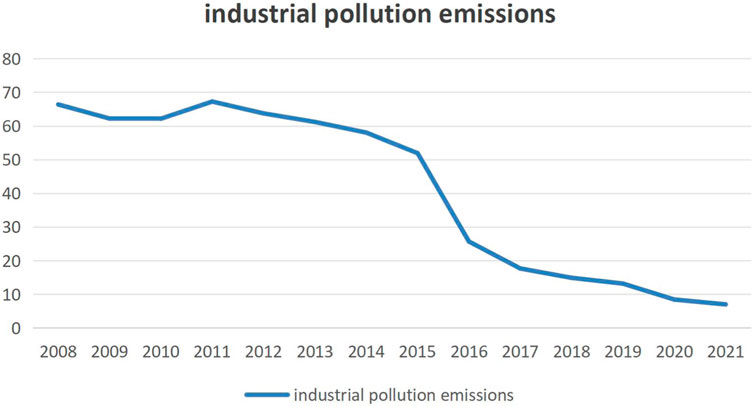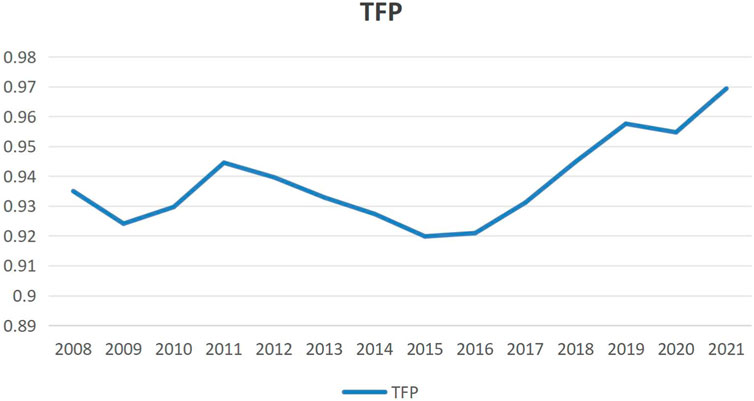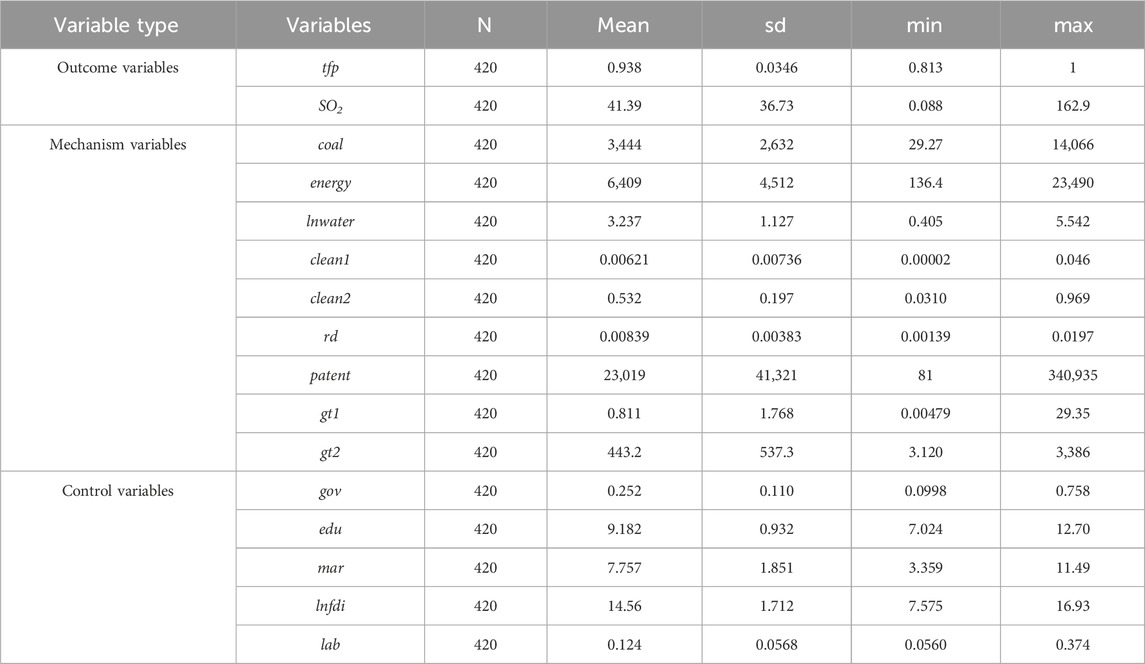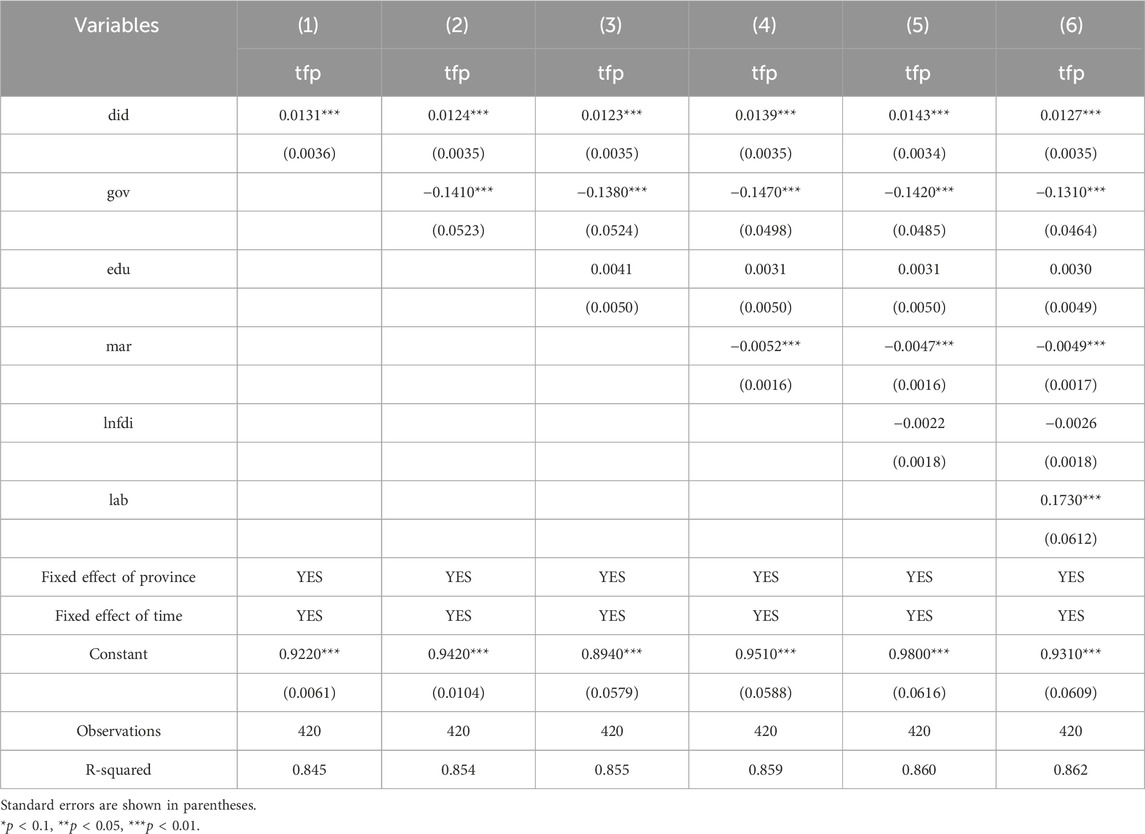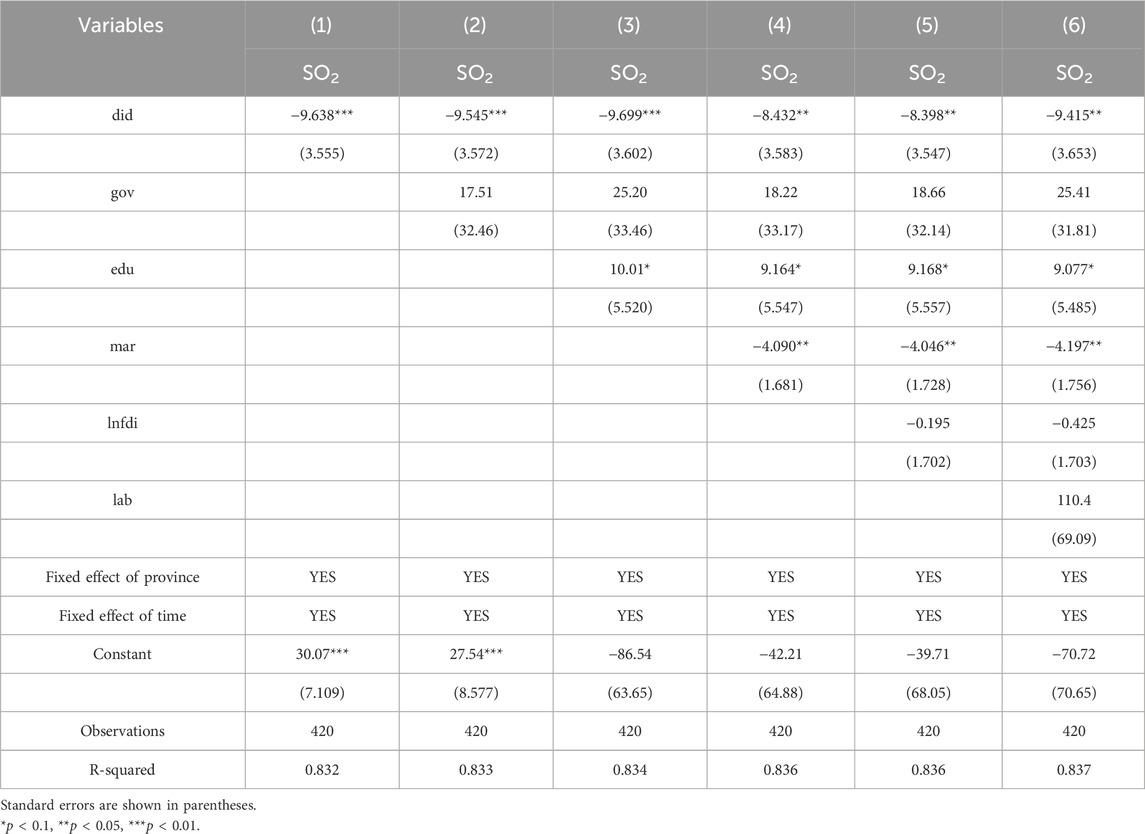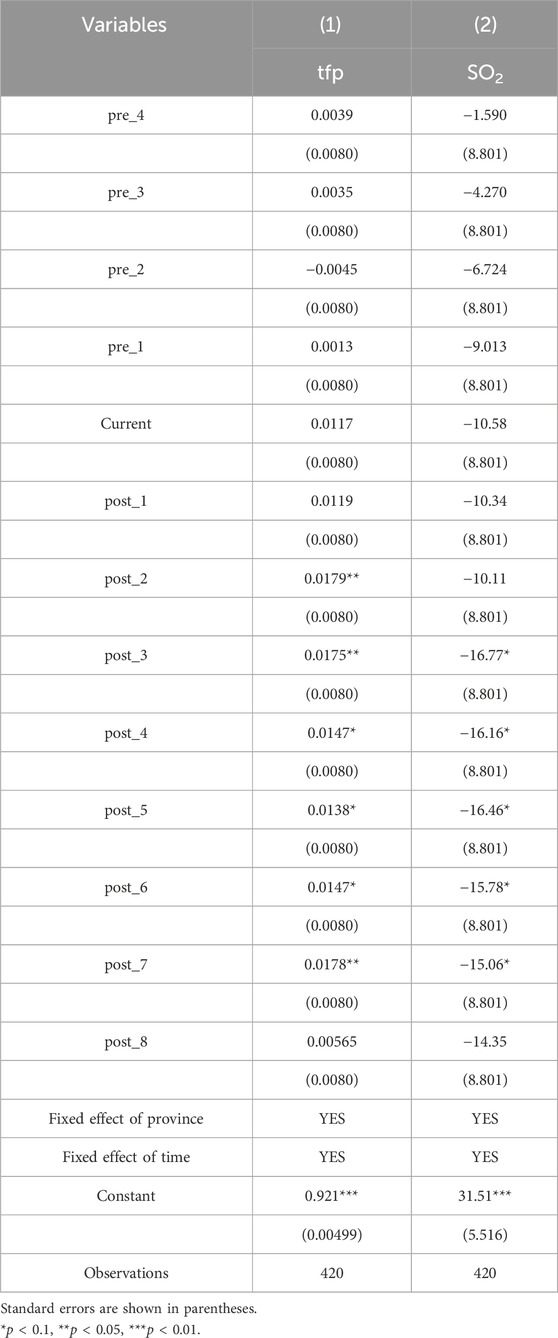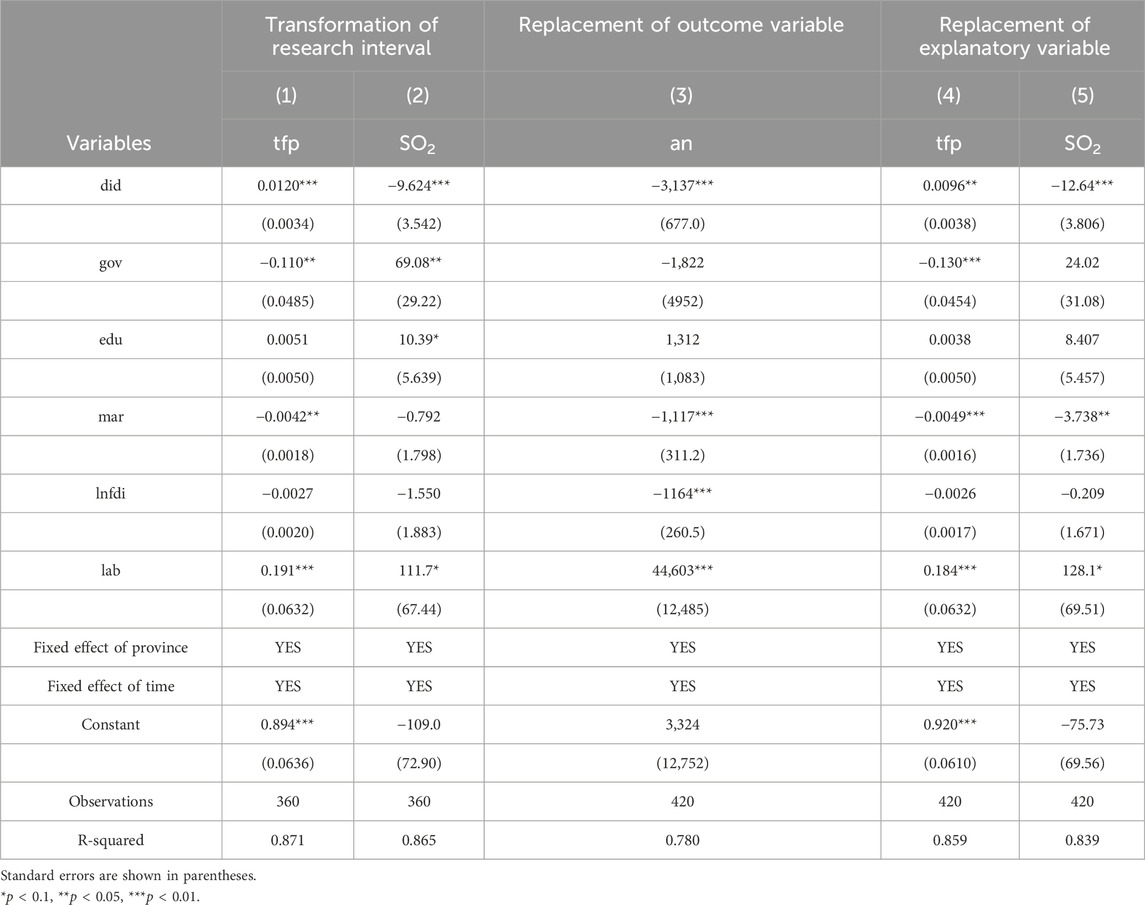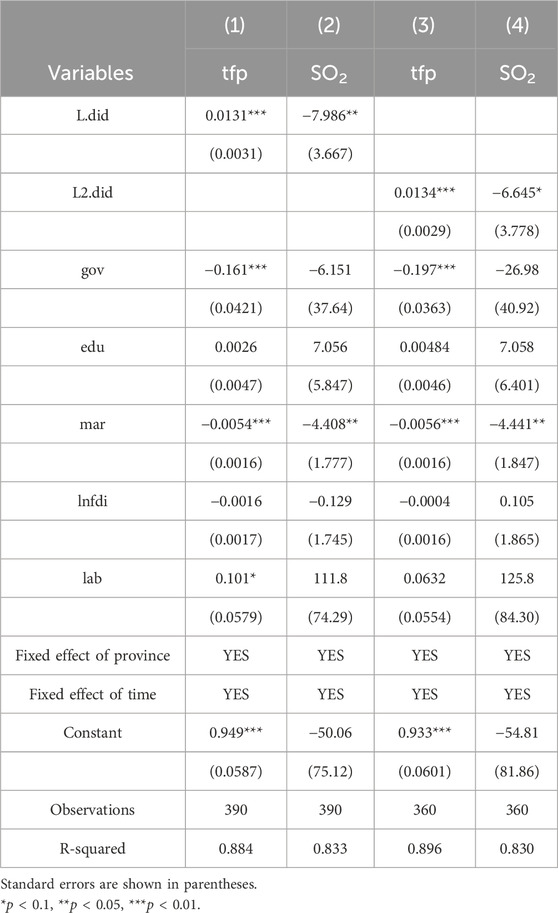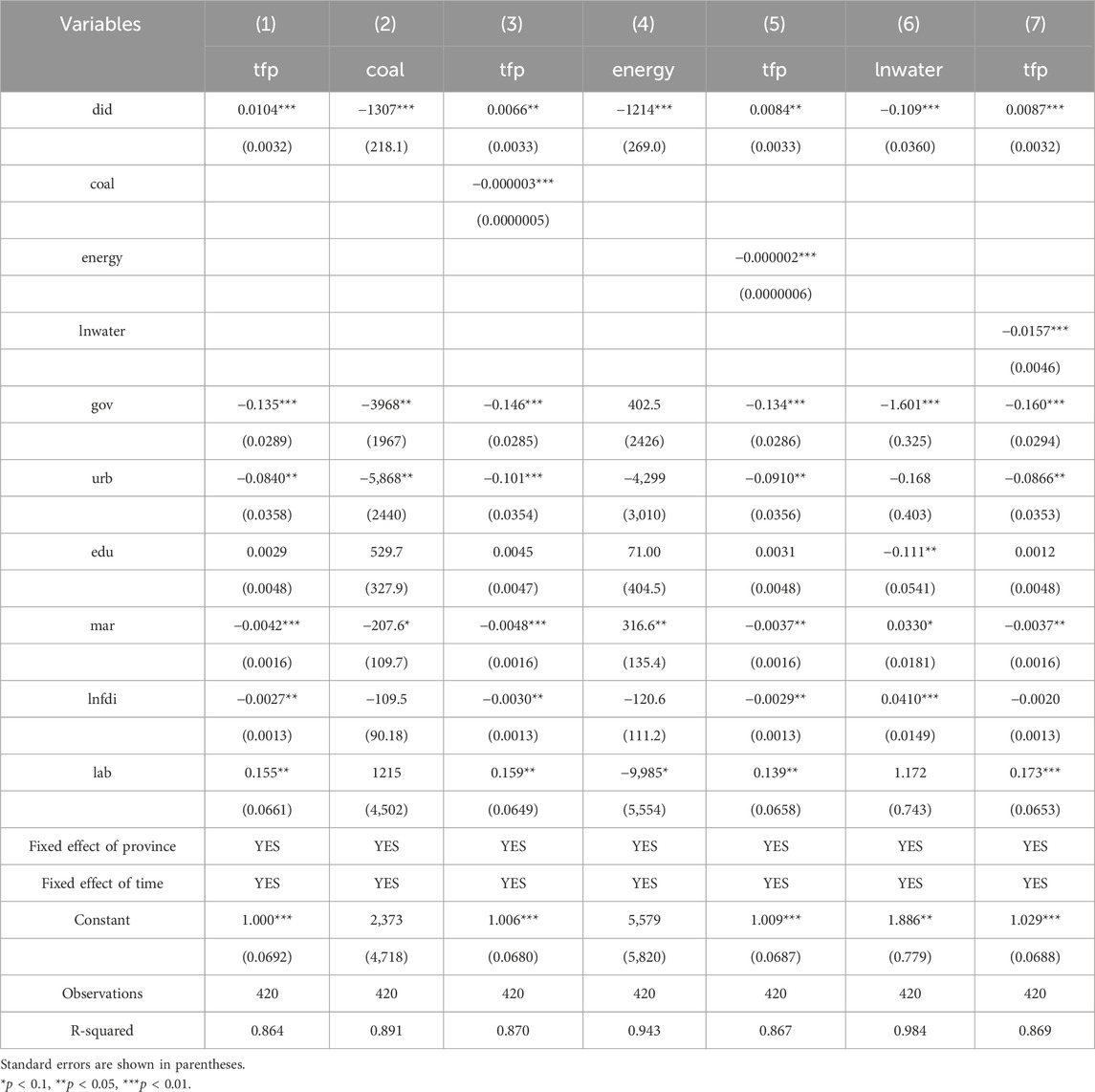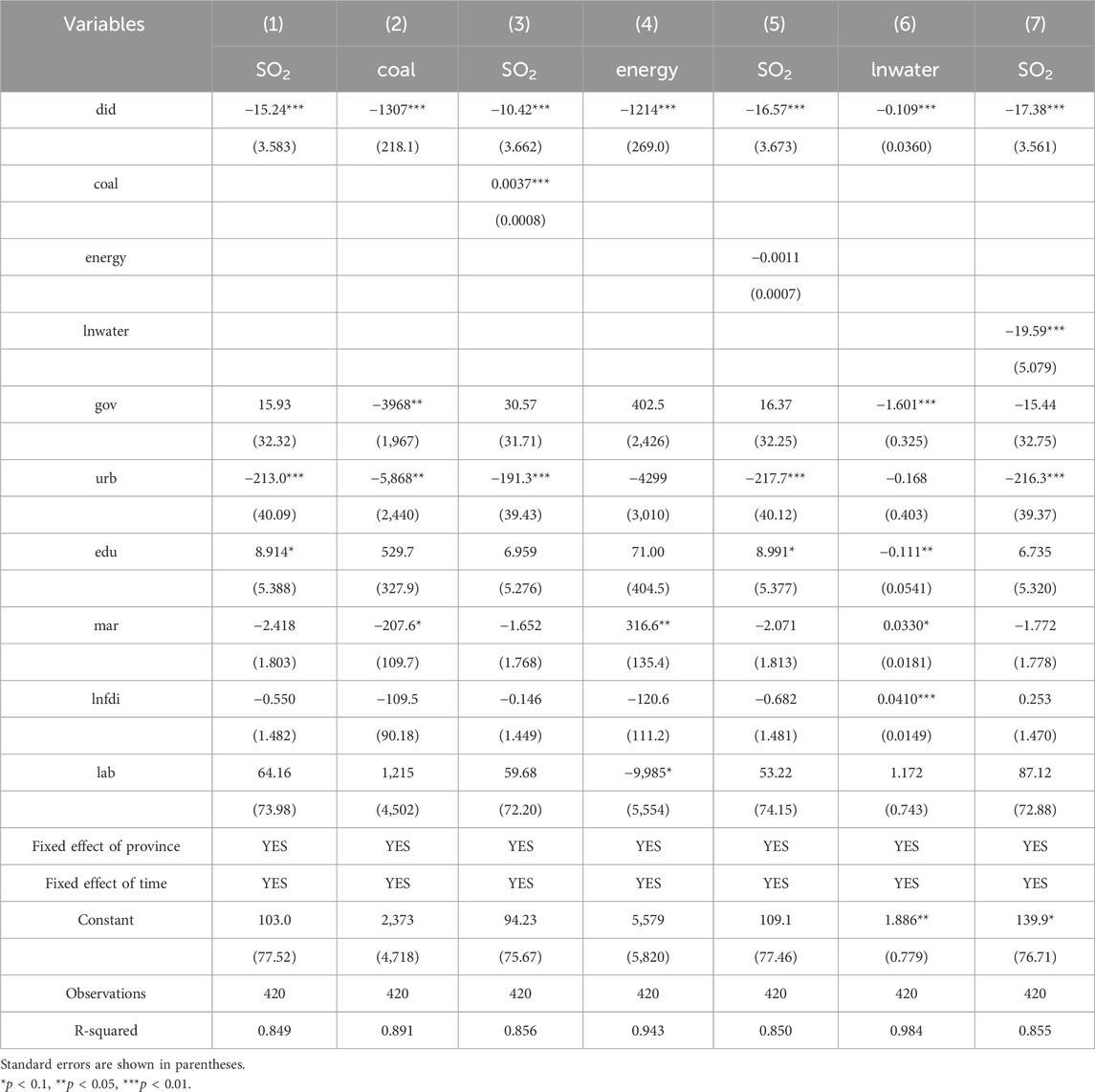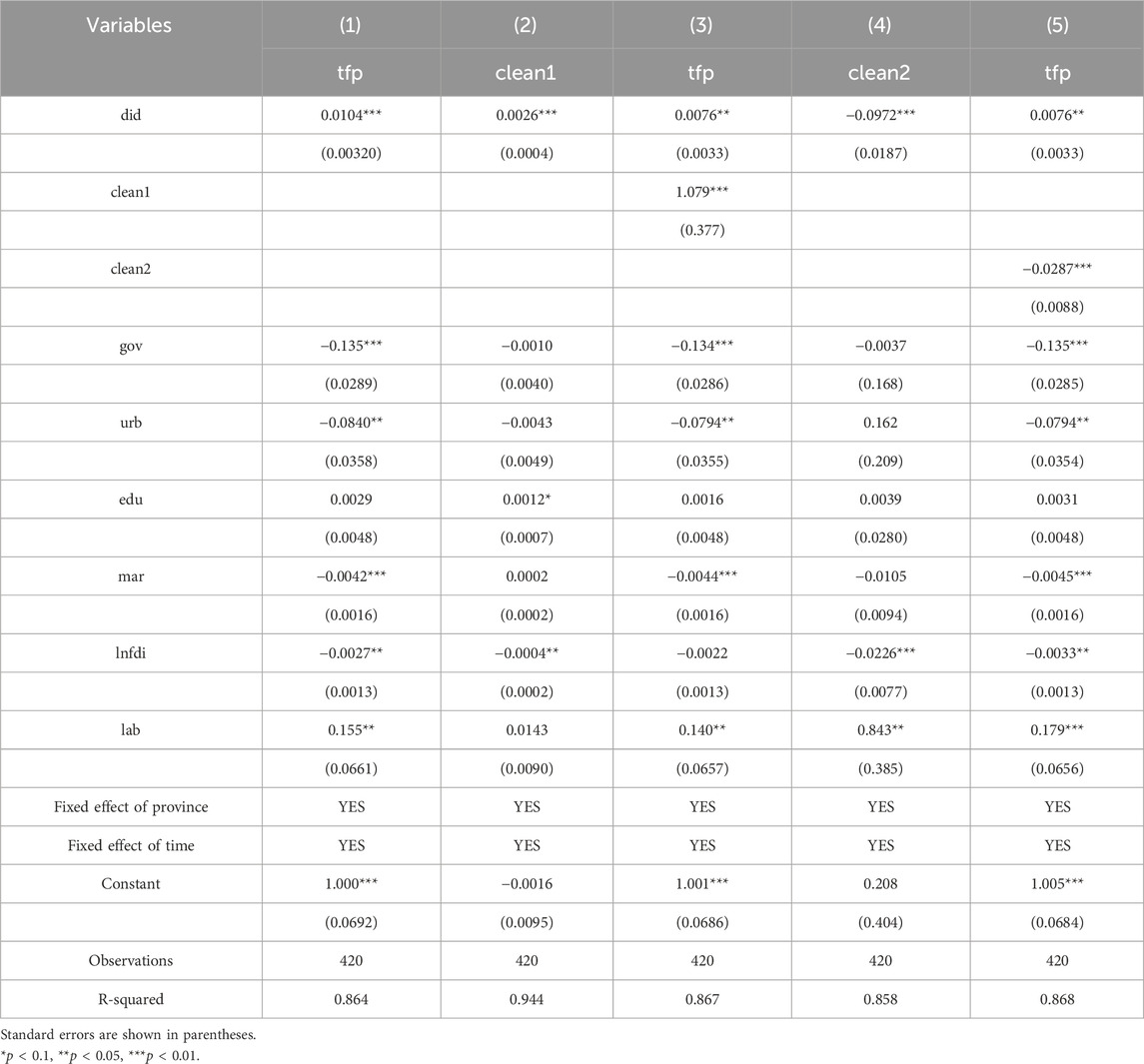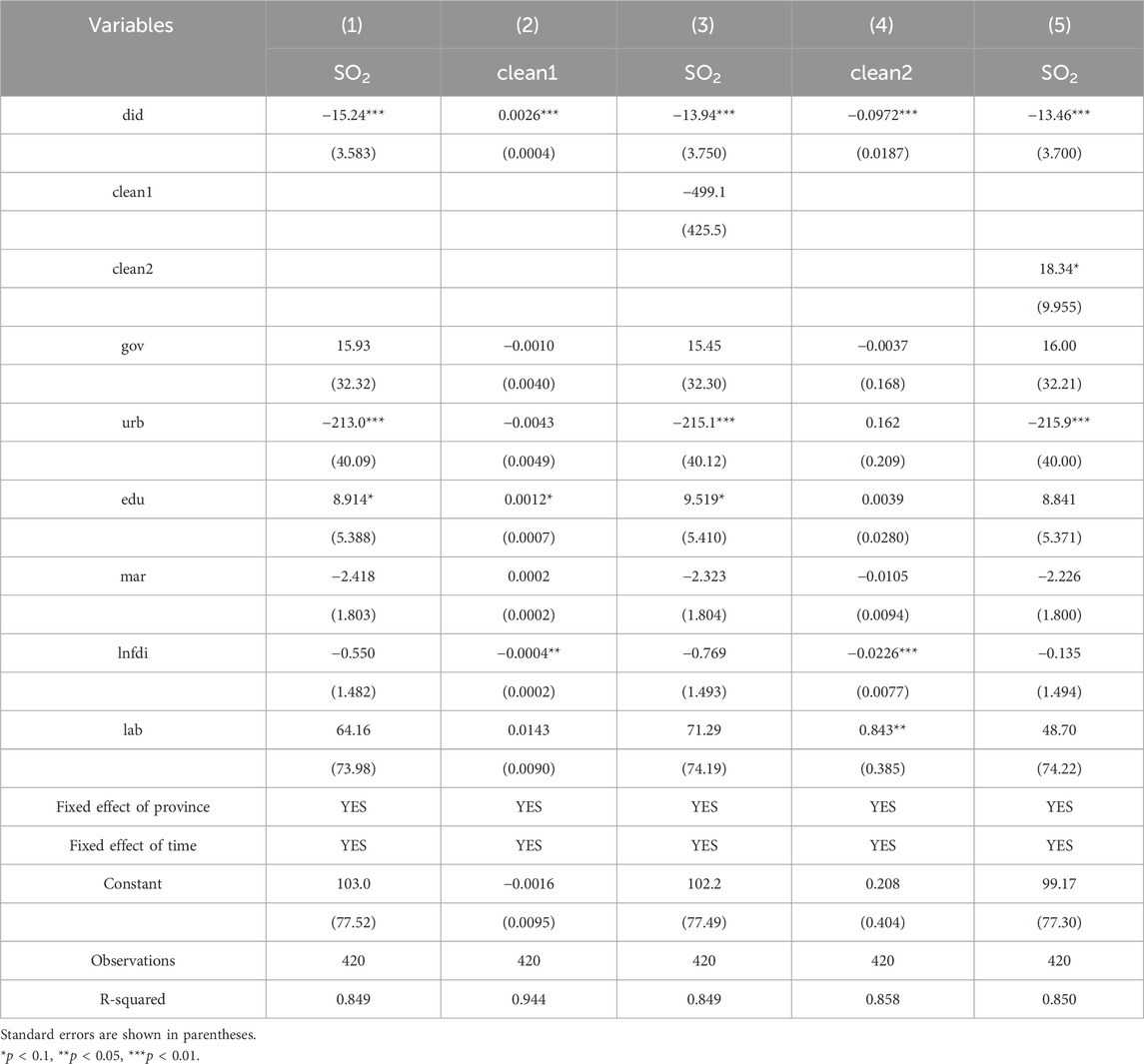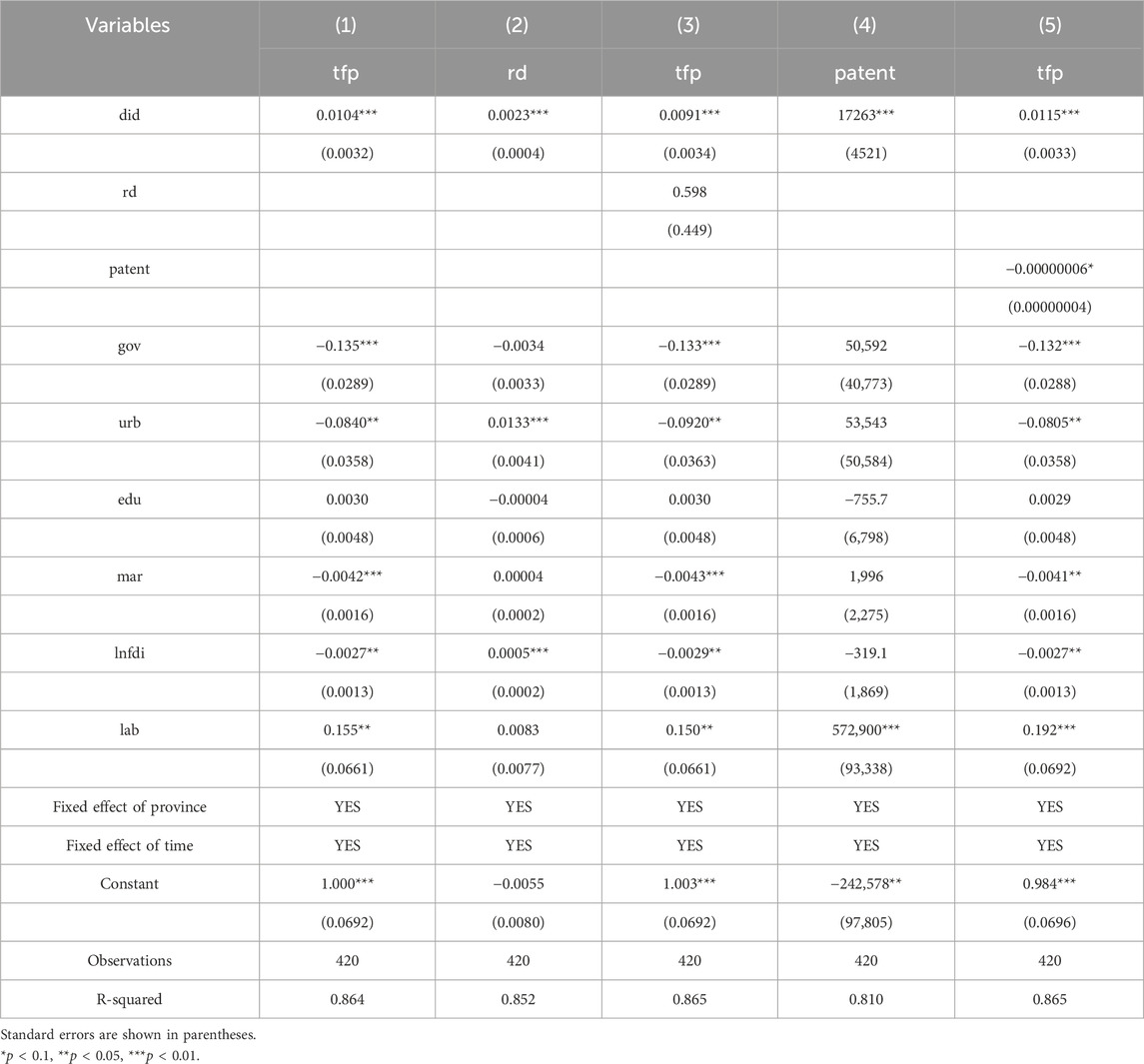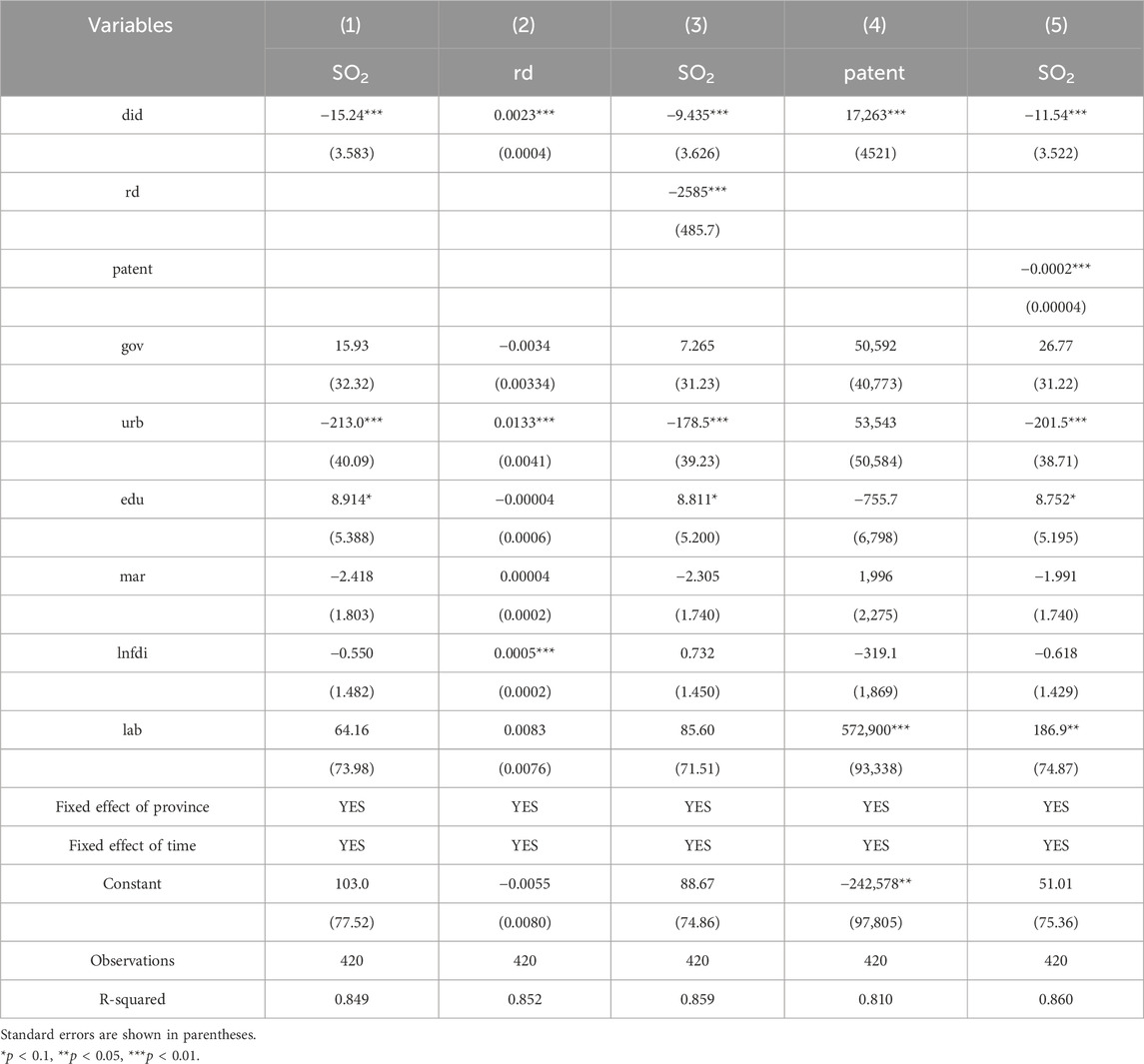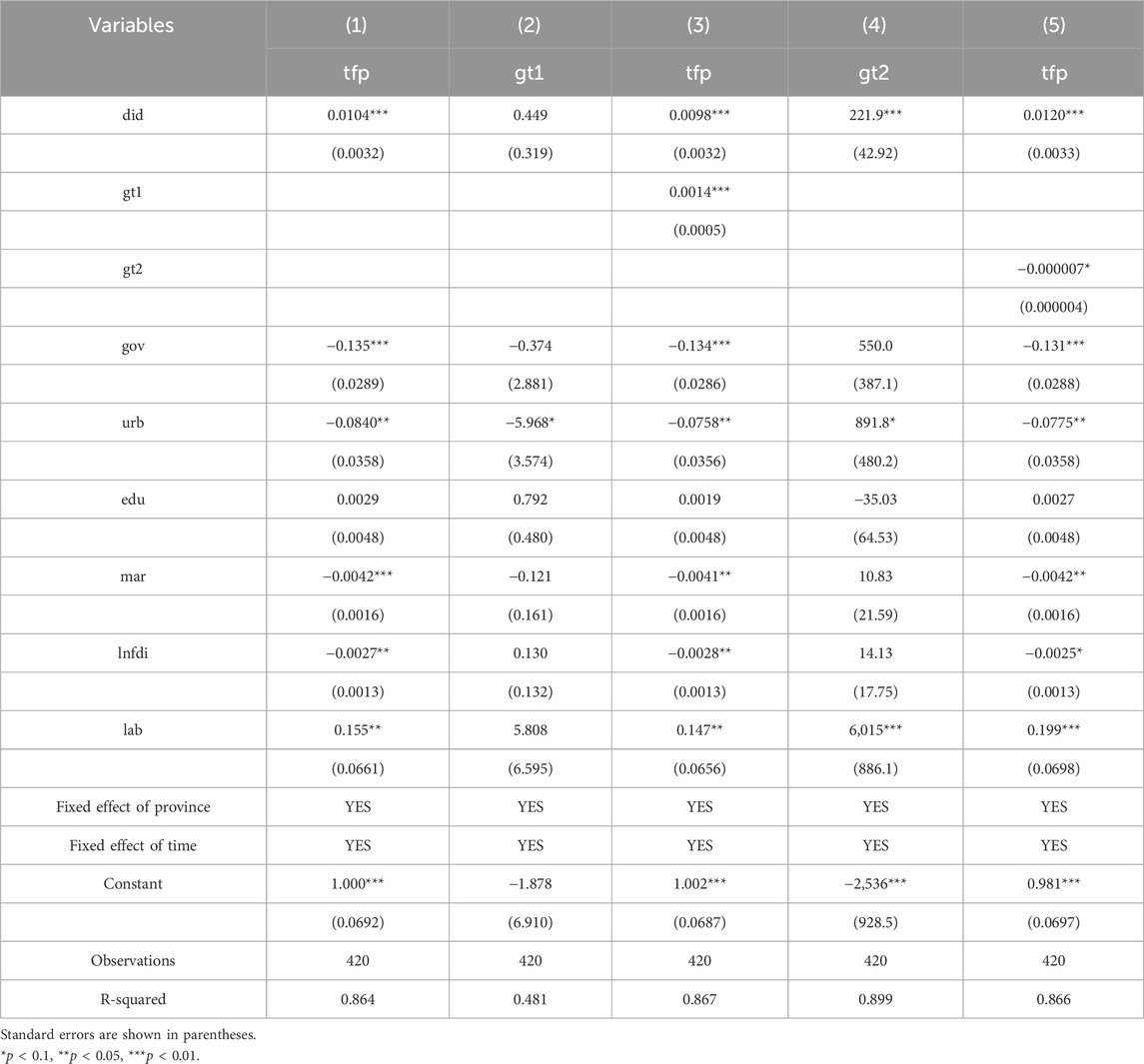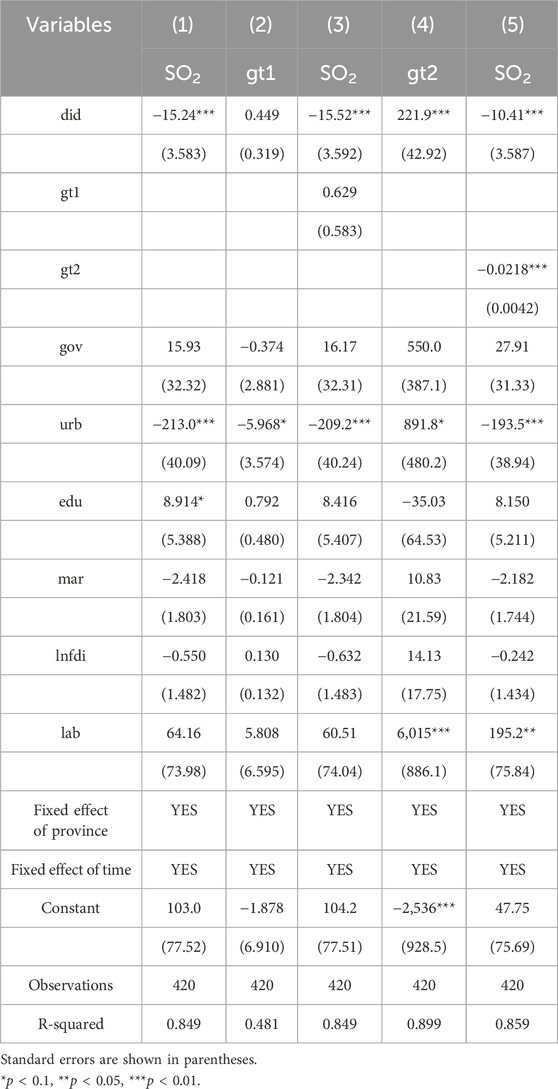- School of Economics, Lanzhou University of Finance and Economics, Lanzhou, China
With the continuous advancement of industrialization, global environmental problems are becoming increasingly severe. Maintaining economic growth while improving the environment has been an important issue for many countries, especially developing countries. As industry is a major source of environmental pollution, industrial green transformation and upgrading have become particularly important. In the era of the digital economy (DE), there is a new path for industrial green transformation and upgrading. Based on provincial data on industry from 2008 to 2021, a difference-in-differences (DID) model was constructed to analyze the environmental and economic benefits. New pathways for trade-offs between environmental improvement and economic growth in China are presented. In addition, new ideas are concerning global environmental issues and economic issues in the DE are presented. The present study indicates that the DE has reduced the intensity of pollution emissions and elevated total factor productivity (TFP), which has helped to promote industrial green transformation and upgrading. Further mechanism testing showed that the DE has promoted industrial green transformation and upgrading by improving the utilization of energy and resources and promoting technological innovation. Considering the utilization of energy and resources, the DE has decreased China’s total industrial consumption of energy and coal, reduced industrial water consumption, and reduced the share of coal consumption and increased the share of clean energy consumption in China’s total industrial energy consumption; these effects have optimized the efficiency and structure of China’s energy utilization to contribute to the green transformation and upgrading of industry. Regarding technological innovation, the development of the DE has increased industrial innovation output and R&D input. Furthermore, it has promoted innovation with respect to green processes, accelerating technological innovation, and realized industrial green transformation and upgrading.
1 Introduction
The 20th National People’s Congress of the CPC stated that high-quality development was essential to the Chinese path to modernization and a fundamental element of the construction of a modern socialist country. Under this theme of high-quality economic development, vigorous development of industry and enhancement of industrial green transformation have been essential in promoting China’s economy’s “move from virtual to real” (Guandghao et al., 2022). In 2022, China’s industrial value added reached 40.2 trillion yuan, and its manufacturing value added reached 33.5 trillion yuan. Each indicator has been world leading. In addition, China’s industrial contribution to economic growth has reached 36%. However, China’s industrial productivity still lags far behind that of developed countries, and even some emerging economies have caught up with China’s productivity1. The rapid development of foreign industries has placed tremendous pressure on China.
At the same time, China’s domestic industry has not entirely shaken off the development pattern of “three high” measures in the form of excessive inputs, consumption, and emissions driven by various factors (Cai et al., 2019; Wang and Shao, 2019). The industrial development model has placed tremendous pressure on China’s resources and environment (Zhang et al., 2015; Li et al., 2022), which has seriously hindered the high-quality development of China’s industry. Improving China’s industrial development model and realizing green transformation and upgrading is the only way for China to become an industrial power. The 18th Party Congress emphasized efforts to promote green and low-carbon development, forming an industrial development pattern of conserving resources and protecting the environment. As a result, China’s industry entered its green transformation and development stage. In 2021, China pointed out that by 2025, significant achievements in green transformation would have been made. A sound green and low-carbon technology system and green manufacturing support system have been built to systematically promote the transformation of six fields, namely product supply, production modes, industrial structure, energy consumption, resource utilization, and production processes, promoting green development of industry. Green transformation and upgrading of industry have risen to the level of national strategic topics. However, they remain in urgent need of further promotion (Yu et al., 2015; Jinpeng et al., 2018; Yang et al., 2022).
The digital economy (DE) has provided new opportunities for green transformation and upgrading of industry. Over the past decade, the DE’s share in China’s GDP has risen from 21.6% to 39.8%. Digital industrialization and industrial digitalization have achieved remarkable results, and the DE has now achieved a more stable position in the national economy, playing a more apparent supporting role (Bowman, 1996). The DE has become integrated with all areas of the economy, giving rise to a new paradigm of digital transformation that is reshaping industrial forms and economic patterns (Zhang et al., 2023). According to the World Economic Forum, the rapidly developing DE has become integrated with traditional industry, accelerating the intelligent and clean transformation of traditional industry (Zhang et al., 2022; Oloyede et al., 2023), providing convenient infrastructure for traditional industry, enhancing productivity, improving ecological efficiency, merchandizing green technology innovation, and fully enabling industrial transformation. In October 2022, the 20th National Congress report2 proposed constructing a digital China, accelerating the improvement of the DE, facilitating the fusion of industry and the DE, and emphasizing the acceleration of the green transformation of improvement methods. Therefore, the DE has become a new plan to accelerate the green transformation of industry, helping to structure coordinated improvement of economic development and ecological protection. So, how does the DE affect industrial green transformation and upgrading? How do we evaluate industrial green transformation while considering the economy and environment? What is the corresponding transformation path? Learning about these issues will have significant theoretical and practical significance. In terms of the dimensions of economic and environmental benefits dimensions, this study used provincial panel data from 2008 to 2021 to examine how the DE has affected industrial pollution emission intensity and total factor productivity. In addition, we analyzed the theoretical mechanisms underlying the use of energy resources and technological innovation to carry out a more in-depth study of industrial green transformation and upgrading by the DE.
The remainder of the paper is structured as follows. Section 2 comprises a literature review. Section 3 contains an analysis of the theorized mechanisms. In contrast, Section 4 presents a description of the data description and measurement model. Section 5 outlines a benchmark regression and robustness test. Section 6 presents the mechanism testing. The last section presents the conclusions of the study and policy implications.
2 Literature review
2.1 The digital economy
The concept of the “digital economy” first appeared in 1994. According to the Oxford English Dictionary, the initial appearance of the expression was in the San Diego Union-Tribune newspaper in 1994. However, the term “digital economy” was independently coined around 1996 by Don Tapscott (Bowman, 1996). The DE has been brought about by digital technology and informatization (Zhang et al., 2023). The definition of the DE has continued to change (Oloyede et al., 2023). In the beginning, the definition of the DE mainly revolved around the Internet (Zhang et al., 2022); the term was used to explain the use of the Internet and the economic impact it has had (Song et al., 2017). With the continuous development of the DE, many digital technologies have emerged (Nucci et al., 2023).
The focus of the definition of the DE has shifted from the Internet to the essence of the DE. More recently, it has been generally understood that the DE is based on information and communication technology (Bertani et al., 2020). The innovation, products, and services falling under information and communication technology have contributed to the development of the DE (Xia et al., 2023). The continuous evolution of the definition of the DE has reflected the changes in digital technology and how these technologies have affected society and the economy. In recent years, scholars have concluded that digital knowledge and technology based on modern information networks have reshaped production methods and processes to enhance the structure of the economy and trigger the sustainable improvement of digitization in economic and social fields (Bukht and Heeks, 2018). Understanding the definition of the DE is beneficial for measuring the level of development of the DE. An indicator system can be constructed to measure digital and economic development (Liu, 2021). It is also possible to measure the development level of the DE through the input–output method based on its high permeability and integration (Ran et al., 2023). Additionally, the impact of DE policies on the economy and society can be examined, for example, by studying the impact of DE policies such as “Broadband China” and the “National Big Data Comprehensive Pilot Area” on the economy (Jiang et al., 2023; Zhang and Ran, 2023).
2.2 Green transformation and upgrading
China’s industry has adopted a primary production mode of excessive inputs, consumption, and pollution. The tension between economic growth and the available resources has become increasingly acute. Traditional industries must, therefore, undergo green transformation and upgrading. Green transformation is mainly measured from two perspectives: efficiency and a multi-dimensional evaluation index system. Efficiency is mainly measured through nonparametric methods, including data envelopment analysis (DEA) and other approaches, for instance, the stochastic block model (SBM) and the Malmquist–Luenberger index (Gong et al., 2020). In addition, it can be measured using a parametric method by installing a production function and efficiency term distribution (Tian et al., 2017). An evaluation indicator system has been built based on the connotations of industrial green transformation, using comprehensive evaluation methods such as the selection of indicators from four dimensions (Mao et al., 2019).
Industrial green transformation in countries and regions suffering from environmental crises and resource depletion is crucial for enhancing the environment and economy. Taxation is essential for the government to control the macroeconomy and is crucial in sustainable development and environmental protection. Broad environmental taxes and environmental regulations enhance industrial green transformation (Shen and Zhang, 2022; Du et al., 2021). According to the green paradox, environmental regulations may impose compliance costs and inhibit the green transformation of industry. However, innovation promotes green transformation (Zhao et al., 2021). Renewable energy innovation and industrial green transformation are gradually improving, and the role of renewable energy in merchandizing local industrial green transformation has gradually increased over time (Liu C. et al., 2022). In addition, the high-tech industry can help promote industrial green transformation and upgrading through innovation, especially in underdeveloped regions, mid-industrialization regions, or industries causing excessive pollution (Song et al., 2022). Industrial green transformation must be accomplished as a long-term task, requiring a large amount of capital and support from external financing. Stimulated by the improvement of environmental supervision, green finance is continuing to accelerate, promoting industrial green transformation (Chen et al., 2023). Environmental regulations and green total factor productivity (GTFP) are also important parts of promoting green transformation (Yang et al., 2021). Some scholars believe that strong environmental regulations can increase GTFP (Qiu et al., 2021; Tong et al., 2022). In addition, environmental regulations can also improve GTFP through upgrading of industrial structures (Ouyang et al., 2023), technological innovation (Luo et al., 2022), and technological progress (Cheng and Kong, 2022). These are conducive to the industrial green transformation. Therefore, these scholars believe that the government should put more effort into improving environmental regulations (Zheng et al., 2023). However, some scholars believe that some types of environmental regulations will inhibit green total factor productivity because of the imposition of multiple types of environmental regulations (Tian and Feng, 2022). Regarding internal factors, leadership can help improve employees’ behavior toward the environment, influence employees’ behavior by creating a green organizational atmosphere, and improve green development (Liu and Xuan, 2023). With growing environmental constraints, comprehensively accelerating green transformation can help form a new, greener economic development model. Additionally, doing so can achieve sustainable development in China (Yang et al., 2022), promote the nation’s economic development, and fully leverage the environmental and economic benefits of green transformation.
2.3 The digital economy, green transformation, and upgrading
The DE empowers traditional industries, bringing new momentum to industrial green transformation and becoming an essential component. The DE can accelerate and drive green transformation by strengthening technological innovation (Zhang et al., 2022). For instance, the DE has become a new pathway for the enhancement of industrial structure upgrading through innovation (Jinqi et al., 2021). In particular, the DE enhances green innovation, and digital technology has generated systematic adjustments and disruptive innovation within enterprises, increasing the output of green innovation (Zhang et al., 2022). In addition, the DE promotes green transformation and upgrading by improving innovation capabilities, flow efficiency, and emission costs (Hongcheng et al., 2023). The DE also improves GTFP to promote green transformation (Liu et al., 2022). In addition, provinces with stronger environmental regulations and intellectual property protection have a stronger impact on the promotion of green total factor productivity through the DE (Wang et al., 2023).
Furthermore, the DE can affect ecological and environmental quality through industrial structure upgrading (Zhao et al., 2023). The DE also promotes environmental quality by impacting resource consumption. With the continuous improvement of the DE, its impact will strengthen (Ran et al., 2023). The DE can improve energy efficiency and promote the clean transformation of industry. In addition, with the improvement of industrial infrastructure, the DE is continuously increasing (Guanghao et al., 2022). The DE can increase industrial performance by reducing production costs (Kangxian et al., 2023), driving changes in production and lifestyle, reducing pollution emissions, and subsequently strengthening the capacity for sustainable “ecological–economic–social” development (Pradhan et al., 2020), promoting the green development of industry (Liu et al., 2022).
Research concerning the DE, green transformation, and upgrading has achieved fruitful results, and the body of literature regarding industrial green transformation and upgrading as a result of the DE has gradually grown. Discussion concerning the mechanism linking the DE and green transformation has focused on technological innovation, environmental regulation, industrial structure upgrading, and resource consumption. Other paths have rarely been mentioned. In studying how the DE affects industrial green transformation, in this study, we analyzed a theorized set of mechanisms involving energy and resource utilization efficiency, energy utilization structure, innovation input, innovation output, and green innovation; this analysis enriches our understanding of the theoretical mechanisms underlying this relationship. The environmental and economic benefits of industrial green transformation via the DE are also discussed, and policy measures and suggestions are proposed.
3 Theoretical mechanisms
The DE brings about the substitution of traditional elements to a tremendous degree, saves energy and resources (Huang et al., 2022), improves energy and resource utilization efficiency, optimizes the utilization structure of energy and resources, and reduces pollution emissions caused by ineffective production (Dong et al., 2018). At the same time, the DE has strong innovative capacity, a robust penetration rate, and broad coverage; it has created significant additional room for industrial innovation (Ding et al., 2021), promoted green technological innovation (Zhang et al., 2022), increased green performance, and enabled customers’ diversified green consumption needs to be met. The DE has become essential to solving environmental problems and functions as a new impetus to boost economic development (Czernich et al., 2011), accelerate industrial green transformation and upgrading, and promote a substantial economic boom.
3.1 The digital economy improves the utilization of energy and resources
Some Chinese industries are still in the factor-driven development mode, which consumes significant energy and resources (Zhang et al., 2022f). Digital technology can help industry save energy and resources (Zhukovskiy et al., 2021), carry out systematic energy and resource management, conduct reasonable and effective planning, improve the operational factors of equipment, energy, and resources, reduce energy and resource consumption, improve other operational factors, optimize the utilization structure (Huaying et al., 2022), and bring about material transformation of energy and resources (Shahbaz et al., 2022; Wang et al., 2022a).
First, the DE is conducive to systematic and institutionalized energy and resource management. The DE can build energy and resource management systems. Through digital technologies, it is possible to collect, process, analyze, and apply essential data regarding industrial energy and resources; automate the collection of energy consumption data, such as data on water, gas, heat, and electricity; ensure accurate and efficient data acquisition and timely transmission; and solve the problems of multiple and scattered measurement points for energy and material consumption. An intelligent energy and resource management system can systematically manage data and monitor and record the overall operation of industrial enterprises and industries to improve management and decision-making efficiency. It can fundamentally change the traditional industry’s production and operation modes with large investments of capital and labor power. At the same time, the DE optimizes the use of energy and resources (Dong et al., 2018). Based on critical data regarding energy and resources in enterprises, artificial intelligence algorithms can be used for analysis (Zhukovskiy et al., 2021), and can accurately identify improvement points in the production process, provide intuitive analysis results, improve the allocation of various forms of energy and resources, optimize their use, effectively save resources, and reduce energy consumption.
Furthermore, the DE stimulates energy-saving with original equipment (Zhang et al., 2022g). It can enable the use of industrial robots and other technologies to optimize process flow, reconstruct a production process, continuously enhance the stage of technological development of equipment in enterprises, improve the accuracy of detection and control of product parameters, adjust material scheduling, improve production equipment, optimize and control the production process, realize the digitalization of the production line, improve product quality, and stimulate the energy-saving capacity of original equipment to reduce energy and material consumption. These effects can bring about substitution effects in terms of traditional factors, reduce the input of production factors, and accelerate the rational movement toward industrial green transformation.
Hypothesis 1. The DE promotes industrial green transformation and upgrading by improving energy and resource utilization.
3.2 Digital technology promotes innovation in industrial technology
Innovation has become an essential direction of industrial development and is crucial in the realization of industrial green transformation. The rapid improvement and widespread use of digital technology have created a higher degree of freedom and room for industrial innovation and development (Zhang et al., 2022), ameliorated the allocation of elements of industrial innovation, enhanced the innovation efficiency of technological activities, and promoted green technological innovation (Luo et al., 2022), which can provide added value for clients and industry and additionally limit the detrimental impact on the environment to a great extent (Dan and Zhu, 2022). The adoption of a green orientation as a future strategy for industry will promote the green transformation of industry.
First, the DE can expand industrial markets. With the ongoing expansion of the economy, low efficiency of new product innovation and insufficient output in terms of innovation have become essential factors restricting industrial green transformation. The DE has expanded the market, increasing competition among enterprises. At the same time, the external environment has strengthened the sustainability of the requirements for industrial green development, and green demand among customers has been growing. Market demand for green technology innovation has been continuously rising (Zhu et al., 2020). In order to gain competitive advantages, industry has continuously strengthened the search for and improvement of new products, and the innovation, especially green innovation, of products and processes has been promoted. Second, through the use of digital R&D management platforms in industrial enterprises, R&D data in industrial systems can be shared and can be used to build open innovation systems that are open to the entire industry chain and involve the whole of society (Zhang et al., 2022); to assist in the transformation of modes of industrial innovation to efficient sharing and collaborative cooperation; to substantially enhance the stages of innovation; and to promote the normalization of innovation activities. Within enterprises, more efficient and intelligent R&D platforms and information platforms can also significantly enhance the feedback effect and the effect of a cumulative cycle between industrial R&D departments and production departments; enhance the speed of innovation; and improve innovation efficiency. Third, the DE is beneficial for creating a market for marketing innovation. Customer management systems, enterprise management solution systems, supply chain management systems, intelligent manufacturing execution systems, and office automation systems strengthen the capacity for management, intelligent monitoring of manufacturing quality, and lean manufacturing in the green manufacturing process, and enterprises use digital technology to strengthen their creative abilities. This means that they can can flexibly and quickly respond to changes on the market demand side, fully deploy digital innovation tools, carry out multi-scenario R&D activities, enhance the accuracy of R&D innovation, promote industrial digitalization, intelligence, and platformization, innovate in the domain of product experience, and create a market for marketing innovations (Sorescu and Schreier, 2021; Souza et al., 2021).
Hypothesis 2. The DE promotes industrial green transformation and upgrading by promoting technological innovation.
4 Methodology and research data
4.1 Double difference model settings
In 2013, policies such as “Broadband China” were introduced (Luo Y. et al., 2022; Wang et al., 2022b; Zhang and Liu, 2022) and DE policy began to be implemented (Zhu et al., 2020; Dan and Zhu, 2022). The DE has provided technical and environmental support for the green transformation of industry, accurate monitoring of industrial production and emission data, and promotion of improved productivity and reduced pollution emissions. Specifically, to accurately identify the impact of the DE in the green transformation and upgrading of industry, this study used the methods of Wang et al. (2021) and Chen et al. (2020) as references to build a difference-in-differences (DID) model to study the economic and environmental performance of the DE in terms of the impact on industry, focusing on the evaluation of industrial green transformation as a result of emission reduction and efficiency increase. The benchmark regression equation was set as follows:
where i represents a province, t is a year, and emission and tfp are explanatory variables representing each province’s industrial pollution emission intensity and TFP. In year t, coal, energy, clean1, clean2, patent, RD, gt1, and gt2 are mechanism variables representing energy resource utilization efficiency and structure, technological innovation, and green technology innovation in province i. The interaction term did is an explanatory variable. β1 represents the effect of green transformation of provincial industries with vs. without listed DE enterprises. When β1 > 0, it indicates that enterprises within the DE have inhibited industrial green transformation in the province. β1 < 0 indicates that DE enterprises have promoted the province’s industrial green transformation. Additionally, β2 < 0 indicates that enterprises within the DE have inhibited industrial green transformation in the province. β2 > 0 indicates that DE enterprises have promoted the province’s industrial green transformation. The random error term is εit.
4.2 Dynamic effect test
Without DE enterprises, changes in total factor productivity and pollution emission intensity in the experimental and control groups should satisfy a hypothesis of simultaneous trends. To further investigate the parallel trend hypothesis of the double difference model and to study the dynamic processing effect of the DE over time, an event analysis method was selected for examination of the dynamic effect of the DE on industrial green transformation (Zhao et al., 2023). The model settings were as shown in Eqs (3)—(4):
In these equations, Di, t+k represents the core explanatory variables; k represents the number of years in which the policy decision was in operation. This study used panel data from each province from 2008 to 2021, including the first 5 years and the last 8 years of policy decisions, and 2008 was designated as the base year. The dummy variable, when k = −5, was omitted from the regression equation. Before and after the DE policy, αk represents the difference in the level of industrial green transformation between the experimental group and control groups.
4.3 Mediating effect model
To investigate the indirect impact mechanism of the DE on industrial green transformation and upgrading, energy and resource utilisation and technological innovation were introduced as mechanism variables, as shown in Eqs (5)–(10) (Zhonglin and Baojuan, 2014; Miao et al., 2023).
Here, Mit is an intermediary variable representing energy and resource utilization and technological innovation. The other variables are as defined for Eq. 1 and Eq. 2. The classic three-step method of intermediary testing was used. The first step was to test whether DE policies affected total factor productivity and industrial pollution intensity. The second step was to test whether DE policies affected the mechanism variables. The third step was to test whether the combined effects of DE policies and the mechanism variables affected green transformation and industry upgrading.
4.4 Data
Currently, there is no unified standard for measurement of the DE. The DE can be measured by constructing an indicator system and by using methods such as the input–output method (Ran et al., 2023). Such methods are beneficial for studying the impact of the development of the DE. Due to the focus of this article on the effectiveness of DE policies, DE policies have been used as quasi-natural experiments (Zhang and Liu, 2022). The core explanatory variable was did, which represented the DE. The model grouped samples appropriately to identify differences in policy between different provinces. When province i was affected by listed DE enterprises in year t, didit = 1; otherwise, didit = 0. The double difference variable didit = treat × post, where the individual explanatory variable (treat) represented the listed DE enterprises. The sample of listed DE enterprises was set as 1 rather than 0. The explanatory variable of time (post) represented the timing of the rise of enterprises in the DE. As a result of the release of policies such as “Broadband China” (Sorescu and Schreier, 2021; Dan and Zhu, 2022; Wang et al., 2022a), DE policy began to be implemented (Wang et al., 2022b; Zhang and Liu, 2022). Therefore, the explanatory variable of time was set to 0 before 2013, and 1 after 2013. A horizontal comparison of provinces and a vertical comparison of the time axis was conducted in this study, and the promotion of industrial green transformation by the DE was analyzed.
The dependent variables were the intensity of industrial pollution emissions and total factor productivity. These were proxy variables for industrial green transformation because green transformation is concerned with reducing pollution and improving efficiency. Pollution emissions were measured according to the total emissions of industrial sulfur dioxide (SO2) from industrial waste gases in each province. TFP was calculated using the DEA–Malmquist index method (Giacalone et al., 2020). Input factors were fixed capital investment and labor force, while the output factor was industrial value added. Figures 1, 2 show the annual trends in industrial pollution emission intensity and TFP. After the implementation of digital economy policies, the intensity of industrial pollution emissions gradually decreases over time. After the implementation of digital economy policies, TFP showed a trend of increasing year by year in 2015. A possible reason is that there is a time lag in the impact of TFP on the DE due to the large amount of time required for upgrading of industrial technology.
Regarding selection of the mechanism variables, as coal is the primary fossil fuel for China’s industrial sectors, industrial coal consumption (coal) and total energy consumption (energy) were used to measure the efficiency of energy resource utilization. The utilization structure of industrial energy and resources was measured according to the proportion of cleaner natural gas in total energy consumption (clean1) (Huang et al., 2022) and industrial coal consumption as a proportion of total industrial energy consumption (clean2). In terms of technological innovation, the number of industrial patent applications was selected to measure innovation output (patent), and internal R&D funds as a proportion of industrial operating income was selected to measure R&D investment (RD). For green technology innovation, the following technical application objectives at the implementation stage of green innovation were selected: the ratio of new industrial product sales revenue to energy consumption, referred to as green product innovation (gt1), and the sum of internal industrial R&D expenditure and technological transformation investment, referred to as green process innovation (gt2).
Six control variables were selected according to industrial green transformation (Giacalone et al., 2020). These six control variables were government intervention (gov), education level (edu), the Fan Gang marketization process index (mar), foreign direct investment (lnfdi), and human capital (lab).
4.5 Data sources and descriptive statistics
Panel data from 2008 to 2021 were selected from each province. Although 2022 and 2023 are important years for studying the digital economy, due to limitations in data updates, most of the data for 2022 and 2023 do not yet exist. This is a limitation of this paper, which is also a challenge for future research. Additional refinements are needed for future research. Data from Tibet were eliminated to improve accuracy. The data used in the analysis were retrieved from the China Industrial Statistics Yearbook, the China Environmental Statistics Yearbook, the China Statistical Yearbook, and the National Bureau of Statistics. Descriptive statistics are presented in Table 1. Since the only possible values of the did variable were 0 and 1, descriptive statistics are of little significance. Therefore, Table 1 does not include descriptive statistics for did.
4.6 Correlation analysis
In Table 2, the correlation analysis provided a preliminary assessment of correlation. The correlation coefficient between did and TFP was 0.210; this was significant at the 1% level. The correlation coefficient between did and SO2 was −0.316. This finding suggests that the introduction of the DE reduces the intensity of pollution emissions. SO2 will gradually decrease. The DE will produce a reduction in industrial pollution emissions, subsequently cutting the effects of such emissions. The correlation coefficients representing correlation of did with the control variables, such as gov, edu, mar, lnfdi, and lab, were significant at the 1% level, indicating that the control variables were rational.
5 Benchmark regression results
5.1 Analysis of benchmark regression results
Table 3 shows the benchmark regression of the DE variable against industrial TFP, and columns (1)–(6) present the consequences for the regression when control variables were gradually added. The estimated coefficients were significantly positive with the inclusion of control variables. This outcome suggests that the introduction of the DE contributes to an increase in industrial TFP. These TFP results contradict Solow’s discovery. Similarly to the findings of Zhang et al., the DE was found to promote TFP (Zhang et al., 2022). However, no lag period was observed (Zhang et al., 2022). Table 4 presents the outcomes of regression of the DE variable against SO2 in industrial waste gas. As indicated in columns (1)–(6), the introduction of the DE was consistently found to suppress industrial pollution emissions while the number of control variables was gradually increased. This implies that the introduction of the DE has reduced the intensity of industrial pollution emissions, similar to others’ views (Zhang et al., 2022). Column (6) indicates that SO2 in the provinces affected by the DE decreased by 9.415 units. The results for the estimated coefficients for industrial TFP and industrial pollution emission intensity under the DE were very similar. However, the lack of significant difference indicated that the DE fostered constraints on industrial pollution emission intensity and improvements in productivity levels. This discovery represented preliminary evidence for the theoretical mechanism.
The outcomes of the benchmark regression show that the DE has provided a new impetus for industrial green transformation, adding environmental and economic benefits. The DE has enhanced industrial green transformation based on the factors of energy resource utilization and technological innovation, prompted re-examination of the production process, improved the allocation of various elements of production, improved the technological production process, and enabled the formation of a reasonable and effective energy use plan, thereby improving energy efficiency and optimizing the structure of energy use. Simultaneously, the rapid development and wide application of digital technology can improve the allocation of innovation factors, effectively improve the innovation efficiency of industrial technological activities, extend technological output in terms of innovation, and promote green innovation. However, this theory needs further empirical testing.
5.2 Dynamic effect testing
To further investigate the parallel trend hypothesis of the DID model and to study the dynamic processing effect of the DE over time, the event analysis method was used in this study to measure the dynamic effect of the DE on industrial green transformation and upgrading. Table 5 presents the dynamic effects of the introduction of the DE on pollution emission intensity and TFP. There was no difference between the treatment and control groups when the DE policy was not implemented. After implementation of the policy, TFP and the impact on industrial pollution emissions gradually increased. The significance gradually increased. There was a time lag between introduction of companies listed under the DE and their impact due to the large amount of time required for upgrading of industrial technology. There was also an anomaly because of the enormous impact of the COVID-19 pandemic in 2021. In conclusion, the above results support the parallel trend hypothesis of the double-difference model.
5.3 Robustness testing
5.3.1 Transformation of the research interval
This study used data on the DE and industrial green transformation in various provinces from 2008 to 2021. The method of changing the research interval to ensure the robustness of the regression results was used for robustness testing. Due to the COVID-19 outbreak at the end of 2019, industries have been hit hard (Duan et al., 2021a). Therefore, a robustness test was conducted in which data for 2020 and 2021 were removed. If the results were consistent, then the model results obtained in this study would be deemed stable. As shown in columns (1) and (2) in Table 6, the regression coefficients for the DE variable against industrial TFP and SO2 were 0.012 and −9.624, respectively. This result implies that the introduction of the DE promoted an increase in industrial TFP and reduced the intensity of pollution emissions. Therefore, after this change in the research interval, the conclusion remained unchanged, and the model passed the robustness test.
5.3.2 Replacement of the outcome variable
In the double-difference model, SO2 was used as the explained variable for industrial pollution emissions. With the aim of increasing the robustness of the conclusion, a further robustness test was conducted in which ammonia nitrogen emissions from industrial wastewater (an) was selected as a measure of the intensity of emission of industrial pollution. Column (3) in Table 6, presents the impact of the DE on industrial ammonia nitrogen emissions. The DE was found to be effective in reducing ammonia nitrogen emissions. Therefore, under replacement of the explained variable, the introduction of the DE was still found to reduce the intensity of industrial pollution emissions.
5.3.3 Replacement of the explanatory variable
The Internet industry has been characterized by talent aggregation, and the DE is often based entirely on this phenomenon. Therefore, to examine the impact of the robustness of the impact of the indicators on the results and to identify the Internet industry, the double-difference variable was replaced with a variable representing provinces with “double-top” universities specializing in artificial intelligence and big data. These double-top universities provide a constant flow of talent for their provinces, resulting in a different development speed in each province and the differentiation of the DE. Table 6, the estimated coefficients for TFP and SO2 were concordant with those obtained in the baseline regression. These results passed the threshold for significance.
5.3.4 Endogeneity
In Table 7, a lag of 1–2 periods was applied to the explanatory variables in this study, which weakened the impact of possible reverse causal effects. The impact of DE policies on industrial green transformation and upgrading were additionally examined over a more extended period. The results indicated that regardless of whether the time lag was 1 or 2 periods, DE policies were found to promote industrial green transformation. Therefore, the results passed this endogeneity test.
6 Mechanism testing
The preceding theoretical analysis has shown that the development of the DE has promoted green transformation and upgrading by enhancing the efficiency of energy and resource utilization and promoting technological innovation. Specifically, the Internet and other digital technology systems can be used to monitor production processes, improve factor allocation, and save energy and resources. Simultaneously, the DE has also increased innovation output; enabled constant innovation in products, management, and services; and promoted innovation in terms of green products and processes. A mediation effect model was constructed to examine the role of the underlying mechanisms.
6.1 Efficiency and the structure of energy and resource utilization
The theoretical mechanism postulated in this study was energy and resource utilization in industrial production. In practice, fossil fuels, such as coal, natural gas, and oil, are essential production resources and form an indispensable input factor in industrial production. The efficiency of utilization of these resources will immediately affect pollution emissions and production efficiency. Water resources are also a leading resource of the industrial sector. Therefore, this study examined how the DE affects the efficiency and structure of industrial energy and resource utilization. Tables 8, 9 present findings on how the DE has impacted the efficiency of energy and resource utilization. Considering that coal is the dominant fossil fuel input in China’s industrial sector, columns (1)–(3) show the impact of industrial coal consumption (coal). The introduction of the DE has promoted TFP and suppressed SO2 by influencing coal consumption. Columns (1), (4), and (5) illustrate how overall industrial energy consumption (energy) has been dampened. The results shown in Table 8 indicate that the presence of an indirect effect was established. However, the indirect effect investigated in Table 9 was not valid. Columns (1), (6), and (7) present the impact of the DE on industrial water use. The presence of an indirect effect was also established in this case. These findings show that the DE has improved the efficiency of utilization of industrial energy and resources and has had a pronounced effect in terms of saving energy and resources.
Tables 10, 11 present the impact of the DE on industrial energy and resource utilization structures. As a relatively clean fossil energy source (Duan et al., 2021b), the utilization structure of natural gas is very important. In columns (1)–(3), the use of cleaner natural gas as a proportion of total energy consumption (clean1) is shown as a measure of the utilization rate of clean energy in industry. In Table 10, the estimated coefficients show that the introduction of DE increased the proportion of natural gas consumed. In the context of a vigorous DE, industry used cleaner energy. However, columns (1)–(3) of Table 11 indicate that no indirect effect was present. In a bootstrap test, the p-value was 0.309 and the confidence interval was −1.234667 to 3.894979. Columns (1), (4), and (5) present the ratio of industrial coal consumption to total industrial energy consumption (clean2), and the mediating effects in shown Tables 10, 11 were found to be valid. Therefore, the DE promoted a reduction in coal consumption as a proportion of total energy consumption in industry. In the DE era, in addition to improving the efficiency of energy and resource utilization, industry has also turned to measures to increase the proportion of cleaner energy used, reduce the proportion of coal used, optimizing industrial energy usage and the structure of resource utilization, and achieving the purpose of reducing emissions and increasing efficiency. In brief, the regression results revealed that the DE has promoted further improvement and optimization of the efficiency and structure of industrial energy and resource utilization, inhibited the emission of industrial pollutants, improved industrial productivity, promoted green development, and promoted industrial green transformation.
6.2 Technological innovation
The above analysis confirms the hypothesis that the green transformation of industry under the DE is enabled via a pathway of energy and resource utilization, namely, by improving energy and resource utilization efficiency and optimizing the utilization structure. In addition to energy and resources, because of the DE, industries may also engage in technological innovation to achieve industrial green transformation. Therefore, this study examined how the DE has furthered industrial technological innovation. The regression results in Tables 12, 13 show the impact of the development of the DE. The DE has furthered the output of industrial innovation. We examined how the DE has furthered industrial investment in R&D by studying the ratio of internal R&D expenditure to primary business income under the DE (RD). As indicated in columns (1)–(3) of Table 12, only direct effects were observed. In a bootstrap test, the p-value was 0.207 and the confidence interval was −0.0007453 to 0.003432. As shown in columns (1)–(3) of Table 13, the mediating effect held. The results presented in columns (1), (4), and (5) of Tables 12, 13 indicate that the DE policy promoted industrial green transformation by influencing the number of patent applications.
In further investigation of the impact of the DE on green technology innovation in industry, columns (1)–(3) of Tables 14, 15 show the indirect effects of green product innovation. In the bootstrap test presented in Table 14, the p-value was 0.193 and the confidence interval was −0.0003125 to 0.0015446. In the bootstrap test presented in Table 15, the p-value was 0.450 and the confidence interval was −0.4502286 to 1.014973. There was no indirect relationship between the DE, green product innovation, and industrial green transformation and upgrading. This result may be due to the fact that green product innovation depends more on the green needs of consumers and is not closely related to the development of the DE. Columns (4)–(5) of Tables 14, 15 show the indirect effects of green process innovation. The DE was found to promote industrial green transformation through green process innovation. The above results show that technological innovation has been the primary path for green upgrading of industry in the context of a vigorous DE.
7 Conclusion and policy measures
The 20th CPC National Congress promoted high-quality development and the building of a modern industrial system, creating a focal point for the actual economy and promoting new industrialization3. According to their needs, digital technologies and platforms such as industrial robots, 3D printing, 5G technology, and industrial Internet can be embedded into traditional production methods and services in industry. The DE has provided opportunities for China’s industry. This study examined how the DE has influenced industrial green transformation based on a double-difference model. Mechanism testing based on a mediation effect model was also conducted. The findings indicated that implementation of the DE policy promoted the growth of TFP and inhibited pollution emissions, validating the results of the theoretical analysis with industrial data from 30 provinces from 2008 to 2021. The examination indicated based on mechanism testing that the DE promoted optimization of energy and resource utilization efficiency, enabling less energy and resource consumption.
The DE promoted the optimization of total energy use and of the resource utilization structure. The analysis indicated a shift to greater use of clean energy and less consumption of fossil fuel energy. However, only a direct effect was observed in the relationship between the DE, energy use, and sulfur dioxide emissions, and in the relationship between the DE, the proportion of natural gas consumed, and sulfur dioxide emissions. Through these factors, the DE has promoted green transformation and upgrading.
Furthermore, the DE has promoted technological innovation in industry as a means of enhancing green transformation and upgrading, with an increase in innovation inputs and outputs. The DE can promote green technological innovation via a higher level of innovation in green processes and can promote the achievement of industrial green transformation in consideration of the environmental and economic benefits of reducing pollution. However, only a direct effect was observed in terms of the relationship between the DE, innovation input, and TFP, as well as in the relationship between the DE, green product innovation, and green transformation. Therefore, efficiency and emission reduction can be fully reconciled under the DE. On the basis of these results, the following policy measures and suggestions are proposed.
First, the application of emerging digital technologies in industry should be strengthened to promote green transformation and upgrading. Digital production platforms can be constructed to create internal interconnections within enterprises and enhance the overall planning of the production information flow within enterprise departments. New forms of business can be implemented, such as remote operation and maintenance, large-scale personalized customization, and online industrial business activities to reduce industrial business costs, achieving a seamless connection between industrial online and offline business activities and continuous green innovation in terms of product experience.
Second, solutions and products to reduce energy and resource consumption should be provided. DE enterprises should be supported to create and improve energy- and resource-saving products and services; the needs of industrial enterprises in terms of saving energy and resources under the “three high” production mode should be met; solutions and digital products and services for traditional industries should be provided; and industrial energy and resource consumption should be reduced. In addition, intelligent diagnosis and consultation for traditional industries can be conducted, including the provision of consultation services in the fields of digitalization and greening and the provision of targeted and reasonable transformation plans for different types of traditional industries through customized digitalization and greening consultation, thereby improving intelligent manufacturing capabilities and helping to promote green development of industries.
Third, the effective combination of the DE and industry innovation should be deepened. The deep integration of elements of industrial innovation and the DE should be promoted to produce continuous improvements in the capacity for innovation of industrial enterprises. Capital investment for innovation in production mode, products, services, and other aspects of industry should be increased to ensure the sustainable development of enterprise innovation activities. In addition, the initiatives of independent innovation and green transformation in industry should be continued.
8 Innovations and specific scientific contributions
The innovations and specific scientific contributions of this article are as follows:
First, this study has examined industrial green transformation and upgrading from the perspective of two dimensions: environmental benefits and economic benefits. Instead of using green total factor productivity (Lyu et al., 2022) as an outcome measure, this study balanced the intensity of industrial pollution with total factor productivity. We were able to draw conclusions not only regarding the environmental dimension but also regarding the economic dimension. Compared with the conclusions generally obtained based on the study of green total factor productivity, the conclusions of the research presented in this paper are more detailed. This approach is more conducive to making policy recommendations to improve the ecological environment while promoting economic growth. This article also extends and enriches the existing literature.
Second, this study integrated the DE into the overall framework for analysis of industrial green transformation, thereby enriching the realization path under the new development pattern and providing a reference basis for relevant research.
Third, this article provides new perspectives for the use of the DE to promote industrial green transformation and upgrading. Previous research has mainly focused on environmental regulation and energy structure (Zhai and Yunfei, 2019; Han et al., 2020). This article has discussed the way in which the DE empowers industrial green transformation from the perspectives of the efficiency of energy and resource utilization, the structure of energy and resource utilization, technological innovation, green product innovation, and green process innovation. These factors enrich the theoretical mechanisms by which the DE empowers industrial green transformation. This paper also presents new pathways for achieving industrial green transformation and upgrading.
9 Limitations and recommendations for future research
This study has the following limitations.
First, the research period of this study was from 2008 to 2021, whereas 2022 and 2023 are also important years for studying the DE. However, due to limitations in data updates, most of the data for 2022 and 2023 are not available. In the future, further research can be improved with the use of updated data.
Second, there are many other factors that can influence the use of the DE to promote industrial green transformation and upgrading. The perspectives from which the ability of the DE to empower industrial green transformation can continue to expand, such as by considering the efficiency of resource allocation.
Third, the research presented in this article was conducted at the provincial level. Further research can be conducted at the micro level to examine the mechanisms by which the DE empowers industrial enterprises to undergo green transformation and upgrading.
Data availability statement
The raw data supporting the conclusion of this article will be made available by the authors, without undue reservation.
Author contributions
JL: resources, supervision, and writing—review and editing. QZ: data curation, software, and writing—original draft.
Funding
The authors declare that financial support was received for the research, authorship, and/or publication of this article. Funded project: 2022 Gansu Provincial Basic Research Program—Soft Science Project: Research on the Digital Economy to Promote High-Quality Industrial Development in Gansu Province (Grant No: 22JR4ZA066); the Lanzhou University of Finance and Economics scientific research and innovation team support plan (digital economy and high-quality development of scientific research and innovation team).
Conflict of interest
The authors declare that the research was conducted in the absence of any commercial or financial relationships that could be construed as a potential conflict of interest.
Publisher’s note
All claims expressed in this article are solely those of the authors and do not necessarily represent those of their affiliated organizations, or those of the publisher, the editors, and the reviewers. Any product that may be evaluated in this article, or claim that may be made by its manufacturer, is not guaranteed or endorsed by the publisher.
Footnotes
1Report of the 20th National People’s Congress of the CPC. https://www.gov.cn/xinwen/2022-10/25/content_5721685.htm
2Report of the 20th National People’s Congress of the CPC. https://www.gov.cn/xinwen/2022-10/25/content_5721685.htm
3Report of the 20th National People’s Congress of the CPC. https://www.gov.cn/xinwen/2022-10/25/content_5721685.htm
References
Bertani, F., Ponta, L., Raberto, M., Teglio, A., and Cincotti, S. (2020). The complexity of the intangible digital economy: an agent-based model. J. Bus. Res. 129, 527–540. doi:10.1016/j.jbusres.2020.03.041
Bowman, P. (1996). The digital economy: promise and peril in the age of networked IntelligenceBy TapscottDon, New York: McGraw-hill, 1996. 342 pages, hard cover. $24.95. Acad. Manag. Perspect. 10 (2), 69–71. doi:10.5465/ame.1996.19198671
Bukht, R., and Heeks, R. (2018). Defining, conceptualising and measuring the digital economy. Int. Organ. Res. J. 13 (2), 143–172. doi:10.17323/1996-7845-2018-02-07
Cai, W., Lai, K., Liu, C., Wei, F., Ma, M., Jia, S., et al. (2019). Promoting sustainability of manufacturing industry through the lean energy-saving and emission-reduction strategy. Sci. Total Environ. 665, 23–32. doi:10.1016/j.scitotenv.2019.02.069
Chen, D., Haiqing, H., and Chang, C. (2023). Green finance, environment regulation, and industrial green transformation for corporate social responsibility. Corp. Soc. Responsib. Environ. Manag. 30, 2166–2181. doi:10.1002/csr.2476
Chen, Y., Wang, Y., Die, H., and Zhou, Z. (2020). Government R&D subsidies, information asymmetry, and the role of foreign investors: evidence from a quasi-natural experiment on the shanghai-Hong Kong stock connect. Technol. Forecast. Soc. Change 158, 120162. doi:10.1016/j.techfore.2020.120162
Cheng, Z., and Kong, S. (2022). The effect of environmental regulation on green total-factor productivity in China's industry. Environ. Impact Assess. Rev. 94, 106757. doi:10.1016/j.eiar.2022.106757
Cunfang, L., Song, T., Wang, W., Gu, X., Li, Z., and Lai, Y. (2022). Analysis and measurement of barriers to green transformation behavior of resource industries. Int. J. Environ. Res. Public Health 19 (21), 13821. doi:10.3390/ijerph192113821
Czernich, N., Falck, T., and Woessmann, L. (2011). Broadband infrastructure and economic growth. Econ. J. 121, 505–532. doi:10.1111/j.1468-0297.2011.02420.x
Dan, M., and Zhu, Q. (2022). Innovation in emerging economies: research on the digital economy driving high-quality green development. J. Bus. Res. 145, 801–813. doi:10.1016/j.jbusres.2022.03.041
Ding, C., Liu, C., Zheng, C., and Li, F. (2021). Digital economy, technological innovation and high-quality economic development: based on spatial effect and mediation effect. Sustainability 14 (1), 216. doi:10.3390/su14010216
Dong, K., Sun, R., and Dong, X. (2018). CO2 emissions, natural gas and renewables, economic growth: assessing the evidence from China. Sci. Total Environ. 640_641, 293–302. doi:10.1016/j.scitotenv.2018.05.322
Duan, H., Bao, Q., Tian, K., Wang, S., Yang, C., and Cai, Z. (2021a). The hit of the novel coronavirus outbreak to China's economy. China Econ. Rev. 67, 101606. doi:10.1016/j.chieco.2021.101606
Duan, H., Tang, X., Ren, K., and Ding, Y. (2021b). Medium-and long-term development path of natural gas consumption in China: based on a multi-model comparison framework. Nat. Gas. Ind. B 8, 344–352. doi:10.1016/j.ngib.2021.07.004
Giacalone, M., Nissi, E., and Cusatelli, C. (2020). Dynamic efficiency evaluation of Italian judicial system using DEA-based Malmquist productivity indexes. Socio-Economic Plan. Sci. 72, 100952. doi:10.1016/j.seps.2020.100952
Gong, M., You, Z., Wang, L., and Cheng, J. (2020). Environmental regulation, trade comparative advantage, and the manufacturing industry's green transformation and upgrading. Int. J. Environ. Res. Public Health 17 (8), 2823. doi:10.3390/ijerph17082823
Guanghao, L., Zhou, X., and Bao, Z. (2022). AWin–win opportunity: the industrial pollution reduction effect of digital economy development—a quasi-natural experiment based on the "broadband China" strategy[J]. Sustainability 14 (9), 5583. doi:10.3390/su14095583
Han, D., Tuochen, L., Feng, S., and Shi, Z. (2020). Does renewable energy consumption successfully promote the green transformation of China’s industry? . Energies 13 (1), 229. doi:10.3390/en13010229
Hongcheng, S., Tian, Z., Guo, C., and Zhang, J. (2023). The driving effect of digital economy on green transformation of manufacturing[J]. Energy & Environ. 0958305X2311554. doi:10.1177/0958305x231155494
Huang, Y., Haseeb, M., Usman, M., and Ozturk, I. (2022). Dynamic association between ICT, renewable energy, economic complexity and ecological footprint: is there any difference between E-7 (developing) and G-7 (developed) countries? Technol. Soc. 68, 101853. doi:10.1016/j.techsoc.2021.101853
Huaying, Y., Wei, W., Jinhe, L., and Li, Y. (2022). The impact of green digital finance on energy resources and climate change mitigation in carbon neutrality: case of 60 economies[J]. Resour. Policy 79, 103116. doi:10.1016/j.resourpol.2022.103116
Jiang, Z., Zhang, X., Zhao, Y., and Wang, Z. (2023). The impact of urban digital transformation on resource sustainability: evidence from a quasi-natural experiment in China. Resour. Policy 85, 103784. doi:10.1016/j.resourpol.2023.103784
Jinpeng, F., Xiao, G., Guo, L., and Wu, C. (2018). Measuring the dynamic efficiency of regional industrial green transformation in China[J]. Sustainability 10 (3), 628. doi:10.3390/su10030628
Jinqi, S., Ke, S., and Wang, S. (2021). Does the digital economy promote industrial structural upgrading?—a test of mediating effects based on heterogeneous technological innovation[J]. Sustainability 13 (18), 10105. doi:10.3390/su131810105
Kangxian, J., Liu, X., and Jian, X. (2023). Digital economy and the sustainable development of China's manufacturing industry: from the perspective of industry performance and green development[J]. Sustainability 15 (6), 5121. doi:10.3390/su15065121
Kerui, D., Cheng, Y., and Yao, X. (2021). Environmental regulation, green technology innovation, and industrial structure upgrading: the road to the green transformation of Chinese cities. Energy Econ. 98, 105247. doi:10.1016/j.eneco.2021.105247
Liu, C., Xin, L., Jinye, L., and Sun, H. (2022a). The impact of renewable energy technology innovation on industrial green transformation and upgrading: beggar thy neighbor or benefiting thy neighbor. Sustainability 14 (18), 11198. doi:10.3390/su141811198
Liu, L., Ding, T., and Wang, H. (2022c). Digital economy, technological innovation and green high-quality development of industry: a study case of China. Sustainability 14 (17), 11078. doi:10.3390/su141711078
Liu, T. (2021). Digital policy in European countries from the perspective of the digital economy and society index. Policy Internet 14, 202–218. doi:10.1002/poi3.274
Liu, X., and Xuan, Y. (2023). Green transformational leadership and employee organizational citizenship behavior for the environment in the manufacturing industry: a social information processing perspective. Front. Psychol. 13, 13. doi:10.3389/fpsyg.2022.1097655
Liu, Y., Yang, Y., Huihui, L., and Zhong, K. (2022b). Digital economy development, industrial structure upgrading and green total factor productivity: empirical evidence from China's cities. Int. J. Environ. Res. Public Health 19 (4), 2414. doi:10.3390/ijerph19042414
Luo, S., Yimamu, N., Yueran, L., Wu, H., Irfan, M., and Hao, Y. (2022b). Digitalization and sustainable development: how could digital economy development improve green innovation in China? Bus. Strategy Environ. 32, 1847–1871. doi:10.1002/bse.3223
Luo, Y., Mensah, N., Zhengnan, L., and Wu, C. (2022a). Environmental regulation and green total factor productivity in China: a perspective of Porter’s and Compliance Hypothesis. Ecol. Indic. 145, 109744. doi:10.1016/j.ecolind.2022.109744
Lyu, Y., Wang, W., You, W., and Zhang, J. (2022). How does digital economy affect green total factor productivity? Evidence from China. Sci. Total Environ. 857, 159428. doi:10.1016/j.scitotenv.2022.159428
Mao, W., Wang, W., and Sun, H. (2019). Driving patterns of industrial green transformation: a multiple regions case learning from China. Sci. Total Environ. 697, 134134. doi:10.1016/j.scitotenv.2019.134134
Miao, Y., Shi, Y., and Jing, H. (2023). Effect of servitization on performance in manufacturing firms: A mediating effect model of digitalisation moderated by ESG performance. Heliyon 9 (10), e20831. doi:10.1016/j.heliyon.2023.e20831
Nucci, F., Puccioni, C., and Ricchi, O. (2023). Digital technologies and productivity: a firm-level investigation. Econ. Model. 128, 106524. doi:10.1016/j.econmod.2023.106524
Oloyede, A., Fark, N., Noma, N., Tebepah, E., and Nwaulune, A. K. (2023). Measuring the impact of the digital economy in developing countries: a systematic review and meta-analysis. Heliyon 9, e17654. doi:10.1016/j.heliyon.2023.e17654
Ouyang, X., Liao, J., Sun, C., and Cao, Y. (2023). Measure is treasure: revisiting the role of environmental regulation in Chinese industrial green productivity. Environ. Impact Assess. Rev. 98, 106968. doi:10.1016/j.eiar.2022.106968
Pradhan, R. P., Arvin, M. B., Nair, M., and Bennett, S. E. (2020). Sustainable economic growth in the European Union: the role of ICT, venture capital, and innovation. Rev. Financial Econ. 38 (1), 34–62. doi:10.1002/rfe.1064
Qiu, S., Wang, Z., and Geng, S. (2021). How do environmental regulation and foreign investment behavior affect green productivity growth in the industrial sector? An empirical test based on Chinese provincial panel data. J. Environ. Manag. 287, 112282. doi:10.1016/j.jenvman.2021.112282
Ran, Q., Yang, X., Yan, H., Xu, Y., and Cao, J. (2023). Natural resource consumption and industrial green transformation: does the digital economy matter? . Resour. Policy 81, 103396. doi:10.1016/j.resourpol.2023.103396
Shahbaz, M., Wang, J., Dong, K., and Zhao, J. (2022). The impact of digital economy on energy transition across the globe: the mediating role of government governance. Renew. Sustain. Energy Rev. 166, 112620. doi:10.1016/j.rser.2022.112620
Shen, Y., and Zhang, X. (2022). Study on the impact of environmental tax on industrial green transformation. Int. J. Environ. Res. Public Health 19 (24), 16749. doi:10.3390/ijerph192416749
Song, Y., Lin, J., Tang, M., and Dong, S. (2017). An Internet of energy things based on wireless LPWAN. Engineering 3 (4), 460–466. doi:10.1016/j.eng.2017.04.011
Song, Y., Yang, L., Sindakis, S., Aggarwal, S., and Chen, C. (2022). Analyzing the role of high-tech industrial agglomeration in green transformation and upgrading of manufacturing industry: the case of China. J. Knowl. Econ. 14, 3847–3877. doi:10.1007/s13132-022-00899-x
Sorescu, A., and Schreier, M. (2021). Innovation in the digital economy: a broader view of its scope, antecedents, and consequences. J. Acad. Mark. Sci. 49, 627–631. doi:10.1007/s11747-021-00793-z
Souza, D., Pereira, M., Jabbour, S., Chiappetta Jabbour, C. J., Trento, L. R., Borchardt, M., et al. (2021). A digitally enabled circular economy for mitigating food waste: understanding innovative marketing strategies in the context of an emerging economy. Technol. Forecast. Soc. Change 173, 121062. doi:10.1016/j.techfore.2021.121062
Tian, Y., and Feng, C. (2022). The internal-structural effects of different types of environmental regulations on China's green total-factor productivity. Energy Econ. 113, 106246. doi:10.1016/j.eneco.2022.106246
Tian, Y., Lu, S., and Jin, L. (2017). Methods, data, and differences in total factor productivity measurement. Quantitative Econ. Technol. Econ. Res. 34 (12), 22–40. (in Chinese). doi:10.13653/j.cnki.jqte.2017.12.002
Tong, L., Jabbour, C., Belgacem, B, Najam, H., and Abbas, J. (2022). Role of environmental regulations, green finance, and investment in green technologies in green total factor productivity: empirical evidence from Asian region. J. Clean. Prod. 380, 134930. doi:10.1016/j.jclepro.2022.134930
Wang, J., Liu, Y., Wang, W., and Wu, H. (2023). How does digital transformation drive green total factor productivity? Evidence from Chinese listed enterprises. J. Clean. Prod. 406, 136954. doi:10.1016/j.jclepro.2023.136954
Wang, J., Wang, B., Dong, K., and Dong, X. (2022a). How does the digital economy improve high-quality energy development? The case of China. Technol. Forecast. Soc. Change 184, 121960. doi:10.1016/j.techfore.2022.121960
Wang, L., Wang, Z., and Yatian, M. (2021). Does environmental regulation promote the high-quality development of manufacturing? A quasi-natural experiment based on China's carbon emission trading pilot scheme. Socio-Economic Plan. Sci. 81, 101216. doi:10.1016/j.seps.2021.101216
Wang, Q., An, H., and Tian, Z. (2022b). Digital transformation and electricity consumption: evidence from the broadband China pilot policy. Energy Econ. 115, 106346. doi:10.1016/j.eneco.2022.106346
Wang, X., and Shao, Q. (2019). Non-linear effects of heterogeneous environmental regulations on green growth in G20 countries: evidence from panel threshold regression. Sci. Total Environ. 660, 1346–1354. doi:10.1016/j.scitotenv.2019.01.094
Xia, L., Baghaie, S., and Sajadi, M. (2023). The digital economy: challenges and opportunities in the new era of technology and electronic communications. Ain Shams Eng. J. 15, 102411. doi:10.1016/j.asej.2023.102411
Xinan, G., and Pan, L. (2022). The impact of industrial green transformation on regional economic development in China: an empirical study based on spatial and threshold effects. Sustainability 14 (19), 12913. doi:10.3390/su141912913
Yang, L., Liu, Y., and Deng, H. (2022). Environmental governance, local government competition and industrial green transformation: evidence from China's sustainable development practice. Sustain. Dev. 31, 1054–1068. doi:10.1002/sd.2440
Yang, M., Jiangchuan, X., Yang, F., and Duan, H. (2021). Environmental regulation induces technological change and green transformation in Chinese cities. Reg. Environ. Change 21 (2), 41. doi:10.1007/s10113-021-01759-1
Yu, C., Dijkema, G. P. J., and De Jong, M. (2015). What makes eco-transformation of industrial parks take off in China? J. Ind. Ecol. 19, 441–456. doi:10.1111/jiec.12185
Zhai, X., and Yunfei, A. (2019). Analyzing influencing factors of green transformation in China's manufacturing industry under environmental regulation: a structural equation model. J. Clean. Prod. 251, 119760. doi:10.1016/j.jclepro.2019.119760
Zhang, C. Z., Li, Y., Wu, M. L., Dai, Z. G., and Han, D. M. (2015). The soil heavy mental pollution status and health risk assessment of traditional industrial areas in city area. Ind. Saf. Environ. Prot. 41, 25–29.
Zhang, F., Yang, B., and Zhu, L. (2023). Digital technology usage, strategic flexibility, and business model innovation in traditional manufacturing firms: the moderating role of the institutional environment. Technol. Forecast. Soc. Change 194, 122726. doi:10.1016/j.techfore.2023.122726
Zhang, J., Lyu, Y., Yutao, L., and Geng, Y. (2022e). Digital economy: an innovation driving factor for low-carbon development. Environ. Impact Assess. Rev. 96, 106821. doi:10.1016/j.eiar.2022.106821
Zhang, L., Tao, Y., and Nie, C. (2022g). Does broadband infrastructure boost firm productivity? Evidence from a quasi-natural experiment in China. Finance Res. Lett. 48, 102886. doi:10.1016/j.frl.2022.102886
Zhang, L., Xiong, K., Gao, X., and Yang, Y. (2022f). Factors influencing innovation performance of China's high-end manufacturing clusters: dual-perspective from the digital economy and the innovation networks. Front. Psychol. 13, 1012228. doi:10.3389/fpsyg.2022.1012228
Zhang, Q., Yang, M., and Shanshan, L. (2022c). Corporate digital transformation and green innovation: a quasi-natural experiment from integration of informatization and industrialization in China. Int. J. Environ. Res. Public Health 19 (20), 13606. doi:10.3390/ijerph192013606
Zhang, R., Wenqiang, F., and Kuang, Y. (2022d). Can digital economy promote energy conservation and emission reduction in heavily polluting enterprises? Empirical evidence from China. Int. J. Environ. Res. Public Health 19 (16), 9812. doi:10.3390/ijerph19169812
Zhang, W., and Liu, G. (2022). Digitalization and firm centralization: a quasi-natural experiment based on the "Broadband China" policy. Finance Res. Lett. 52, 103495. doi:10.1016/j.frl.2022.103495
Zhang, W., Zhou, H., Chen, J., and Fan, Z. (2022b). An empirical analysis of the impact of digital economy on manufacturing green and low-carbon transformation under the dual-carbon background in China. Int. J. Environ. Res. Public Health 19 (20), 13192. doi:10.3390/ijerph192013192
Zhang, Y., and Ran, C. (2023). Effect of digital economy on air pollution in China? New evidence from the “National Big Data Comprehensive Pilot Area” policy. Economic Analysis and Policy. Econ. Analysis Policy 79, 986–1004. doi:10.1016/j.eap.2023.07.007
Zhang, Z., Peng, H., and Wang, B. (2022a). Digital economy research: a bibliometric analysis of its evolution and future study areas. Int. J. Technol. Manag. 1 (1), 1. doi:10.1504/ijtm.2022.10052487
Zhao, J., Liu, Q., Bai, J., Liu, H., and Ding, L. (2023). Effect of national COVID-19 control measures on water quality in China using an improved dual difference-in-differences method. Science of The Total Environment 901, 165961. doi:10.1016/j.scitotenv.2023.165961
Zhao, X., Ding, X., and Liang, L. (2021). Research on environmental regulation, technological innovation and green transformation of manufacturing industry in the yangtze river economic belt. Sustainability 13 (18), 10005. doi:10.3390/su131810005
Zhao, Y., Kong, X., Ahmad, M., and Ahmed, Z. (2023). Digital economy, industrial structure, and environmental quality: assessing the roles of educational investment, green innovation, and economic globalization. Sustainability 15 (3), 2377. doi:10.3390/su15032377
Zheng, H., Shaofan, W., Zhang, Y., and He, Y. (2023). Environmental regulation effect on green total factor productivity in the Yangtze River Economic Belt. J. Environ. Manag. 325, 116465. doi:10.1016/j.jenvman.2022.116465
Zhonglin, W., and Baojuan, Y. (2014). Analyses of mediating effects: the development of methods and models. Adv. Psychol. Sci. 22 (5), 731–745.
Zhu, Y., Liang, D., and Liu, T. (2020). Can China's underdeveloped regions catch up with green economy? A convergence analysis from the perspective of environmental total factor productivity. J. Clean. Prod. 255, 120216. doi:10.1016/j.jclepro.2020.120216
Keywords: green transformation and upgrading of industry, digital economy, utilization of energy and resources, technological innovation, green technology innovation
Citation: Liu J and Zhao Q (2024) Mechanism testing of the empowerment of green transformation and upgrading of industry by the digital economy in China. Front. Environ. Sci. 11:1292795. doi: 10.3389/fenvs.2023.1292795
Received: 12 September 2023; Accepted: 20 December 2023;
Published: 13 February 2024.
Edited by:
Hongbo Duan, University of Chinese Academy of Sciences, ChinaCopyright © 2024 Liu and Zhao. This is an open-access article distributed under the terms of the Creative Commons Attribution License (CC BY). The use, distribution or reproduction in other forums is permitted, provided the original author(s) and the copyright owner(s) are credited and that the original publication in this journal is cited, in accordance with accepted academic practice. No use, distribution or reproduction is permitted which does not comply with these terms.
*Correspondence: Jiang Liu, bGo3NTEzQDE2My5jb20=
 Jiang Liu
Jiang Liu Qianyu Zhao
Qianyu Zhao